On this site, we have introduced a wide range of Japanese and Western knives for professional use.
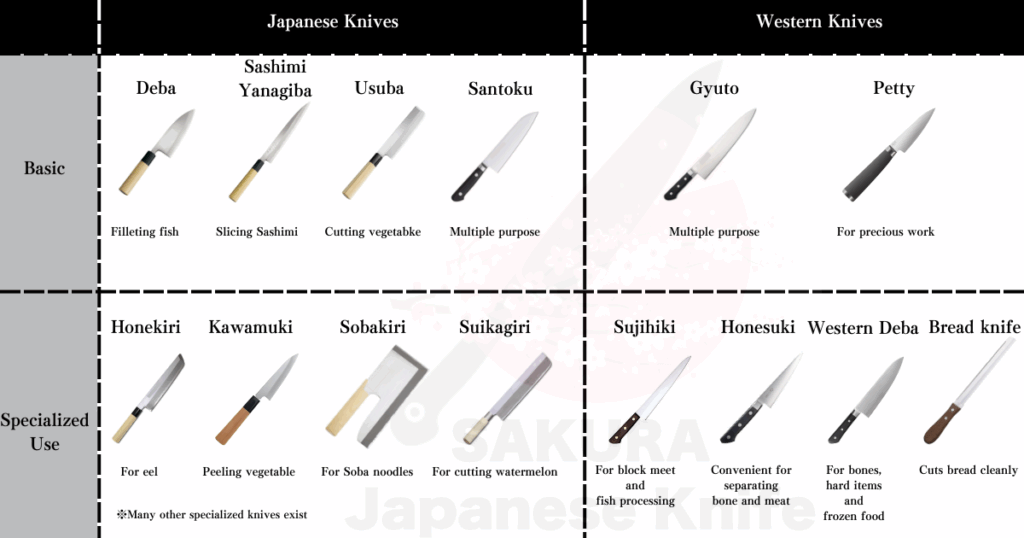
Beyond outlining the distinctive features of each knife, we have also examined the differences among the various blade steels.
Bringing all of this together, we would now like to explain—category by category—which knives are ultimately the most practical and appealing in real-world kitchens.
Important Points When Choosing a Knife
Before diving into the rankings of the best Japanese knives for professional use, let’s first cover the key points to consider when choosing a knife. These factors will help you find the top-rated Japanese knife that fits your needs.
Blade Material (Steel) – Key Considerations
When selecting a knife, the blade material is arguably the most important factor. The type of steel determines the knife’s sharpness, edge retention, ease of sharpening, corrosion resistance, and even its price range.
Below is a table summarizing five main aspects—Sharpness, Durability (Edge Retention), Ease of Sharpening, Rust Resistance, and Price—and what to consider for each:
| Aspect | Points to Consider when Choosing |
|---|---|
| Sharpness | – High-carbon steels (e.g. White steel, Blue steel) can take a very sharp edge.– Powder steels (e.g. SG2/R2, ZDP-189) are extremely hard and offer excellent sharpness.– Stainless steels (e.g. VG-10) may not have the same “sticky” sharp feel as carbon steel, but many can still be kept very sharp. |
| Durability (Edge Retention) | – Generally, harder steel means the edge lasts longer and stays sharp over extended use.– Blue steel and powder steels, which are very hard, are often used for professional knives for superior edge retention.– High-quality stainless and Damascus-clad steels can also maintain a stable sharp edge for a long time. |
| Ease of Sharpening | – Carbon steels are easy to sharpen, allowing even beginners to quickly restore an edge.– Ultra-hard steels (like some powder steels) require proper whetstones and technique to sharpen effectively.– Stainless steels fall in the middle; however, very hard stainless alloys can take more time and skill to sharpen. |
| Rust Resistance | – Stainless steels and stainless-based powder steels are highly resistant to rust and easy to maintain.– Carbon steels will rust easily, so prompt thorough cleaning and drying after use is a must to prevent oxidation.– Even with Damascus knives, if the core is carbon steel it needs the same care against rust. |
| Price | – In general, higher-performance steels (e.g. advanced powder steels) tend to be more expensive.– Even carbon steel knives can be pricey if made by famous artisans or using rare Blue steel, etc.– Stainless steel knives are available across a wide price range, from affordable to high-end. |
Tips Based on These Points:
- Prioritize Sharpness: If you want ultimate cutting performance, consider carbon steel or powder steel blades for their razor-sharp edges.
- Easy Maintenance: If effortless upkeep is a priority, rust-resistant stainless steel is ideal. For longer intervals between sharpenings, a harder steel with good edge retention helps (though it might be harder to sharpen).
- Enjoy Sharpening: If you enjoy sharpening and “tuning” your blade, carbon steel is rewarding and easy to grind to a keen edge.
- Budget Balance: Japanese knives come in a wide range of prices. Assess what balance of performance and cost fits your budget.
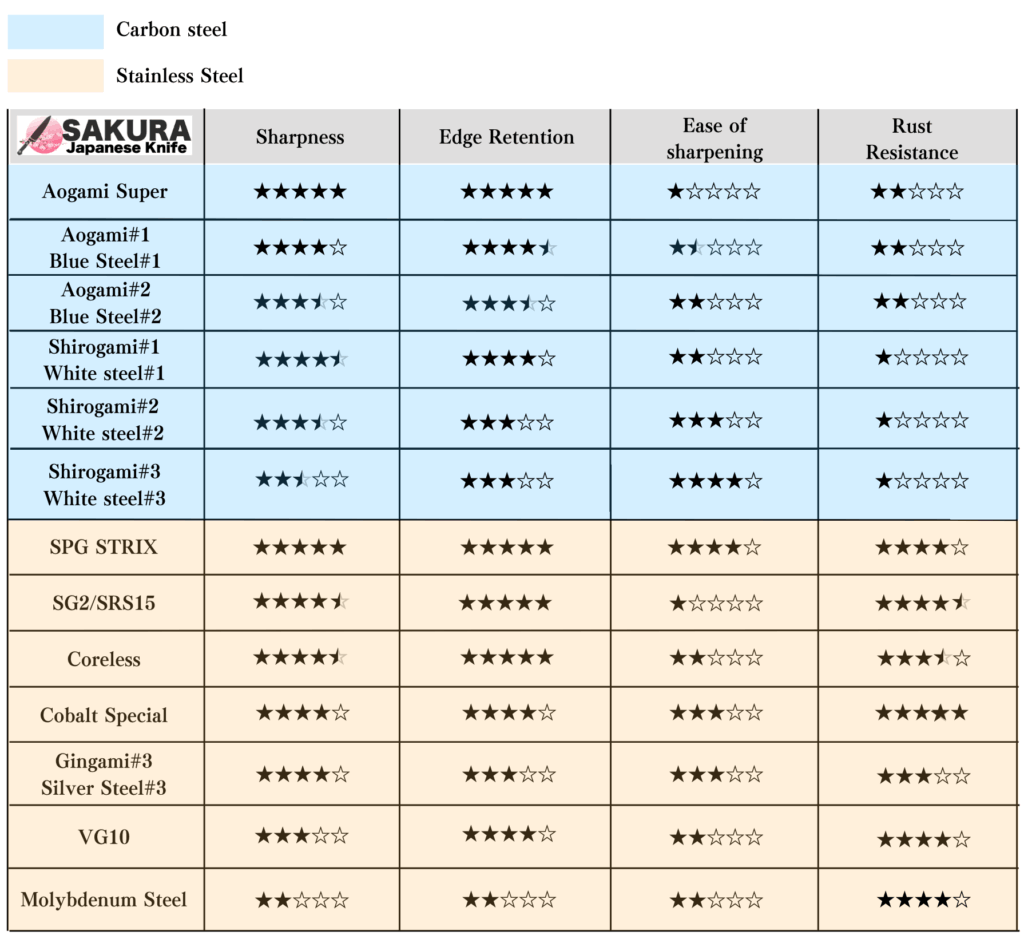
The comparison chart above shows relative performance of various steels – unsurprisingly, steels with higher performance tend to come at a higher price. Keep in mind that the best choice depends not only on the steel itself but also on how you plan to use the knife and how much effort you can invest in maintenance.
For reference, here are general guidelines for which steels suit which use cases (professional tasks, etc.). Consider your own cooking style and needs when choosing the blade material.
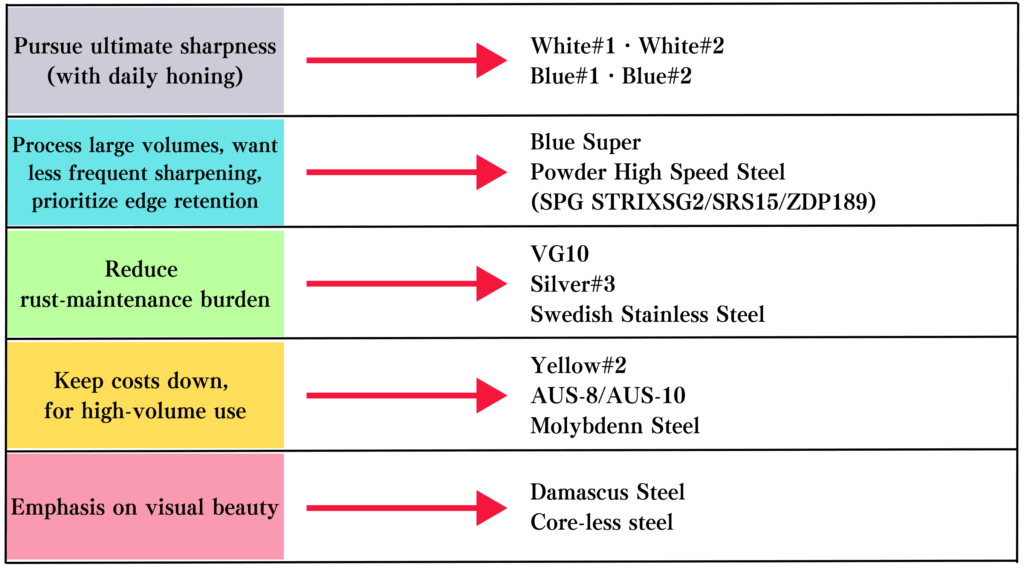
Honyaki vs. Kasumi Knives
Another major difference in traditional Japanese knives is whether a knife is Honyaki or Kasumi.
- Kasumi包丁 (Kasumi knives) are made by forge-welding a hard steel (e.g. carbon steel like White #2 or Blue #2) to a softer iron or stainless steel jacket. Because only the edge steel is exposed, if the outer layer is stainless, most of the knife’s surface is effectively rust-resistant, making maintenance easier. The hard core provides cutting performance and durability, while the softer cladding adds toughness and eases sharpening.
- 本焼包丁 (Honyaki knives), on the other hand, are forged from a single piece of high-quality hard steel (no soft cladding). They can attain extremely sharp edges and excellent edge retention, but their very hardness makes them more brittle (prone to chipping) and more challenging to sharpen. They are also typically much more expensive and require advanced skill to maintain (e.g. sharpening a honyaki properly is difficult).
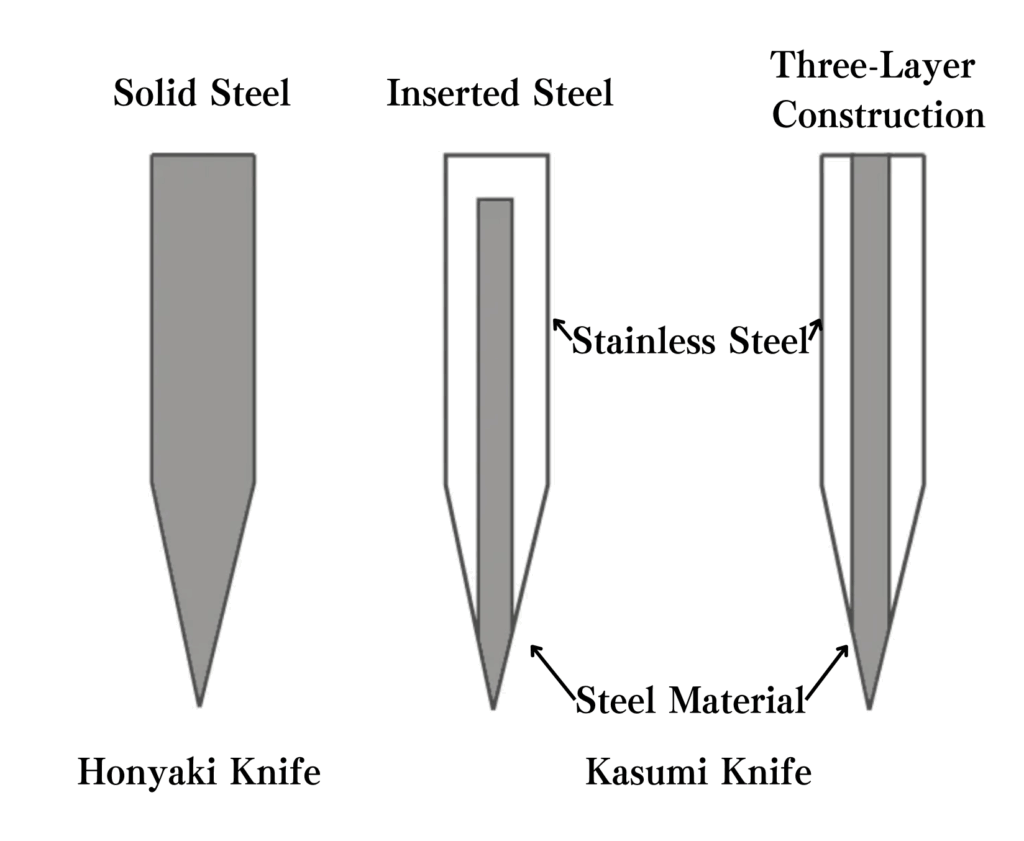
Below is a summary of the merits and demerits of Honyaki vs Kasumi knives:
| Type | Merits | Demerits |
|---|---|---|
| Honyaki (Single-steel knives) | – Incredibly sharp edge and very high hardness.– Outstanding edge retention; stays sharp for a long time.– Crafted with masterful technique and top-grade steel, often holding value as works of art. | – Often extremely expensive and harder to obtain.– Using one very hard piece of steel means the blade can chip or even crack more easily under shock or improper use.– Sharpening and maintenance require advanced skill and can be time-consuming. |
| Kasumi (Clad knives) | – Generally more affordable than honyaki, offering great value for performance.– If the outer layer is a rust-resistant alloy or stainless, the knife is effectively much more corrosion-resistant (only the edge steel is exposed).– Not as hard as honyaki, so more resistant to chipping and easier to sharpen.– Well-balanced performance suitable for everyone from professionals to home cooks. | – Usually not as ultra-hard or brutally sharp/long-lasting as the best honyaki knives (still excellent, but honyaki can surpass in raw performance).– Because of the layered construction, care is needed at the junction of hard and soft materials (though proper maintenance mitigates this).– In terms of “lifetime treasure,” Kasumi knives are less rare/unique than honyaki knives. |
In short, if ultimate sharpness, hardness, and rarity are your top priorities (and cost is no object), a honyaki knife is the pinnacle. However, if you value cost-effectiveness, easier maintenance, and overall practicality, a kasumi knife is usually the better choice.
Handle Selection Points
While the blade steel is most important, the handle (柄) is also a crucial component of any knife. The handle’s material and design affect grip, balance, durability, and maintenance. Below we summarize the merits and demerits of common handle materials: natural wood, composite wood, synthetic resin, and advanced synthetic materials.
| Handle Material | Merits | Demerits |
|---|---|---|
| Natural Wood | – Unique texture, warmth, and a comfortable feel in hand.– Develops character/patina with age (“ages gracefully”).– Each piece has distinct grain and character, offering beauty and individuality. | – Sensitive to humidity and dryness; can crack or warp over time if not cared for.– Can harbor mold/bacteria if not kept dry and clean, so maintenance is required.– Weak to water; needs thorough drying after washing. |
| Pakkawood(Laminated Stabilized Wood) | – Wood that’s been impregnated with resin and compressed, making it more water-resistant and durable than natural wood.– Retains a natural wood look/feel while being less prone to warping or cracking.– Relatively easy to maintain and user-friendly. | – Has less of the deep “aging character” that pure natural wood develops over time.– The treatment/process can give a slightly more artificial appearance or feel compared to raw wood.– High-quality stabilized wood handles can be somewhat expensive. |
| Synthetic Resin(e.g. plastic) | – Highly resistant to water; virtually no risk of rot or corrosion.– Generally affordable, lightweight, and easy to handle.– Often available in many colors; conveys a clean, sanitary image. | – May lack the premium look or natural feel that wood offers.– While plenty durable for normal use, extreme conditions (impact, high heat, etc.) can cause deformation or degradation over time.– Does not develop patina or “character” with use/age. |
| High-Tech Materials(e.g. G-10 fiberglass, carbon fiber, Micarta, etc.) | – Extremely durable, with excellent water, heat, and shock resistance.– Very low risk of warping, splitting, or deformation.– Lightweight yet strong; commonly used in professional-grade knives. | – Often on the higher end of the price spectrum.– Difficult to machine/process, and if custom-made or special order, costs can increase further.– Imparts a somewhat industrial feel; won’t develop the kind of patina or warmth that natural wood does. |
Handle Choice Tips:
- If you love traditional look and feel (and don’t mind a bit of upkeep), go with a natural wood handle to enjoy its texture and aging.
- If you want some natural feel with added durability, a stabilized wood (pakkawood) handle gives a balance of wood warmth and better water resistance.
- For easy maintenance, hygiene, and budget-friendly pricing, synthetic resin handles are a great choice.
- If maximum durability and performance are the goal, and cost is secondary, consider advanced materials like G-10 or carbon fiber handles.
Choosing by Region of Manufacture
Japan has several famous knife-producing regions, each with its own history and specialties. The five most renowned are Sakai, Seki, Tsubame-Sanjo, Miki, and Echizen.

Each region’s knives have distinctive characteristics and areas of expertise. The table below highlights features of each region, the types of knives they excel at, and additional notes:
| Region (Prefecture) | Main Characteristics | Notable Knife Types | Additional Notes |
|---|---|---|---|
| Sakai (Osaka) | – Centuries-old blade-making tradition rooted in swordsmithing; established as “Sakai hamono” (Sakai cutlery) since the Edo period.– Especially famous for high-quality wa-bocho (traditional single-bevel Japanese knives) thanks to advanced forging techniques.– Distinct artisan guild system: specialists handle each step (forging, sharpening, etc.) with superb skill. | – Yanagiba (sashimi knives)– Deba knives– Usuba (vegetable knives)– Traditional Japanese knives in general | – “Sakai Uchihamono” is recognized as a Traditional Craft.– Many knives are aimed at professionals, known for precision finish and outstanding sharpness. |
| Seki (Gifu) | – Over 700 years of blade history; once a hub for swordsmiths.– Today, Seki has a robust mass-production infrastructure for a wide range: Japanese knives, Western knives, pocket knives, etc.– Strength lies in blending traditional forging with modern mechanization for efficient production. | – Santoku, Gyuto, and other Western-style knives (chef’s knives, etc.)– Also scissors, pocket knives, and various blades | – Home to both major manufacturers and small workshops, offering a huge variety of brands.– Wide price range of knives from entry-level to high-end, giving consumers lots of options. |
| Tsubame-Sanjo (Niigata) | – A major metalworking center spanning Tsubame and Sanjo cities.– Renowned for expertise in stainless steel processing and metal polishing techniques.– Also a leader in producing Western tableware (cutlery) and kitchenware; many products are modern and refined. | – High-quality stainless steel Western-style knives (e.g. gyuto, santoku). | – Known for sleek, polished finishes and beautiful stainless steel work.– Popular with users who value not just cutting performance but also modern design, style, and hygiene.– Emphasizes a clean, stylish aesthetic as well as functionality. |
| Miki (Hyogo) | – Region with a long history (since Edo period) of tool and hardware production (e.g. carpentry tools, farming tools).– Besides kitchen knives, famous for chisels, planes, and gardening blades.– Tradition of crafting rugged, practical blades built for daily use. | – All-purpose knives both Japanese and Western (e.g. santoku, deba, etc.)– Also known for tools like chisels, etc. | – Branded as “Miki cutlery” with a reputation for reliability.– Many products known for being sturdy and long-lasting, at reasonable cost.– Production ranges from large factories to individual artisans; many practical, cost-effective knives on the market. |
| Echizen (Fukui) | – Blade-making known as “Echizen Uchihamono,” originating from sickle forging over 700 years ago.– Recognized as a Traditional Craft; now produces a wide array of knives and cutting tools.– Local guilds and artisans work together to uphold high quality blade crafting. | – Yanagiba, Deba, and other traditional Japanese knives– Also versatile culture knives, petty knives, etc. | – Praised not just for sharpness but also for the elegant traditional aesthetics and craftsmanship of the blades.– Many smaller workshops offer flexibility like custom orders; artisans can sometimes tailor knives to requests. |
Region Selection Tips:
- If you value the heritage of traditional Japanese knives, consider Sakai or Echizen. These regions produce many artisan-crafted knives like sashimi and deba knives, ideal for those seeking classic Japanese cutlery.
- If you want a wide product range and mass-market reliability, look at Seki. You’ll find everything from affordable knives to top-tier lines, including many Western-style knives and even non-kitchen blades.
- For modern stainless craftsmanship or stylish design, Tsubame-Sanjo is the go-to. They are famous for stainless steel knives with a contemporary look, great durability, and hygienic finishes.
- If you need practical, sturdy blades at a reasonable price, Miki is a strong choice. This area’s history with everyday tools means many of its knives (and other bladed tools) are built tough for long-term use.
All of these regions boast long traditions and high technical skill. Each has different strengths, so think about your intended use, personal preferences, and budget to choose a knife from a region that aligns with those needs.
With those key points in mind, let’s move on to the actual knife rankings. Below, we introduce the top recommended knives for professionals in each major category, along with why they’re great and how to choose the best one for you. This covers a variety of Japanese knife types, from the multi-purpose santoku to specialized blades like sushi knives.
Santoku Knives – Top 3 Recommendations
The Santoku包丁 (Santoku knife) is the most commonly used all-purpose kitchen knife in Japanese households. The name “Santoku” means “three virtues,” referring to its ability to handle three types of ingredients well: vegetables, meat, and fish.
For professional use, the recommended blade length for a santoku is generally 165 mm to 180 mm. The chart below shows how blade length can affect usage for different food types:
| Ingredient | Why That Blade Length Works (Key Points) |
|---|---|
| Vegetables | – ~165 mm: A shorter blade (~165mm) is easy to handle for smaller veggies and fine prep work. Great for tasks like chopping scallions, slicing carrots and cucumbers, or doing katsuramuki (thin ribbon peeling) – the compact length makes delicate cuts easier.– ~180 mm: A slightly longer blade (~180mm) provides extra leverage for larger veggies like cabbage or Napa cabbage. It can handle bigger volume prep more efficiently, speeding up work when processing large quantities. |
| Meat | – Generally, even a 165mm santoku can capably trim meat sinew or portion smaller blocks of meat.– At 180 mm, the longer reach makes it easier to cut through somewhat larger chunks of meat in one stroke, improving work efficiency for bigger pieces. Plus, the santoku’s relatively broad blade helps in scooping and transferring ingredients. |
| Fish | – For cleaning small fish (say, mackerel or sardines), a 165mm santoku offers good control and is manageable in tight motions.– At 180 mm, filleting medium-sized fish (such as mackerel pike, saba, hokke) is a bit easier thanks to the longer edge engaging more of the fish in one draw cut.– However, for serious fish butchery, it’s recommended to use dedicated knives like a deba for breaking down fish or a yanagiba for slicing sashimi, as they are purpose-built for those tasks. The santoku can do it in a pinch, but specialists will yield better results. |
For more detailed guidance on santoku knives for professional use, see our dedicated article. (In summary above, we’ve highlighted the top 3 santoku knives from that article.)
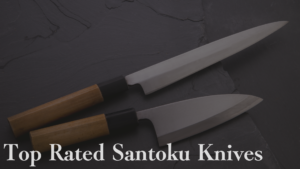
1st Place: White Steel#2 Santoku (白二三徳包丁)
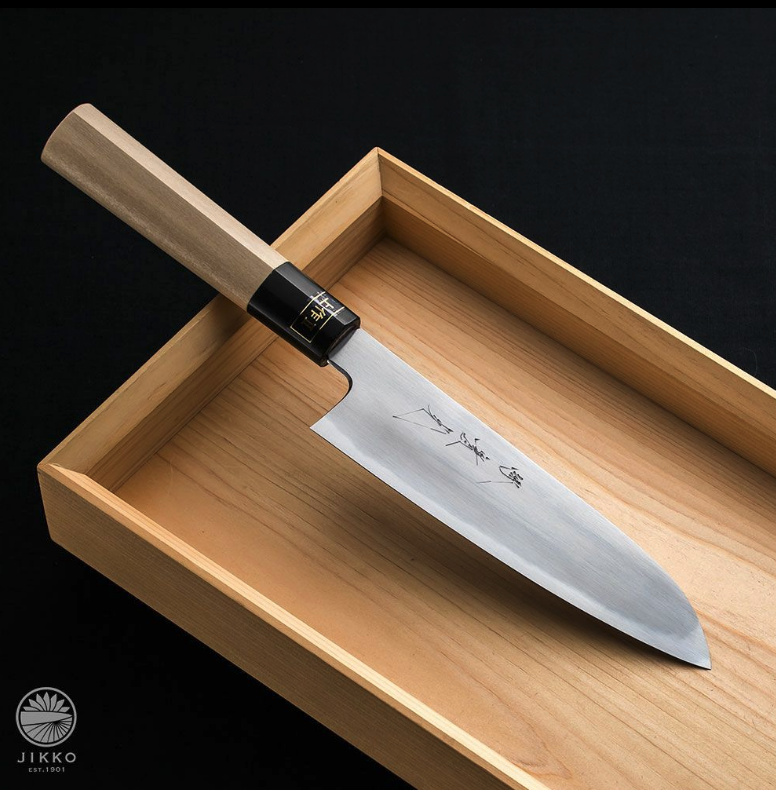
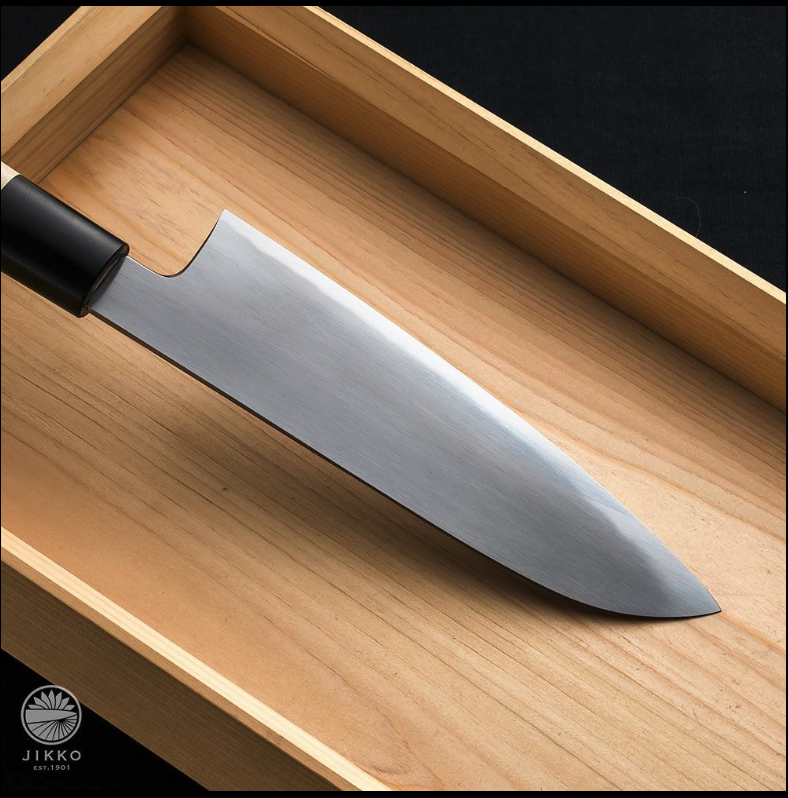
| Aspect | 5-Point Rating |
|---|---|
| Sharpness | ★★★★☆ |
| Edge Retention | ★★★★☆ |
| Rust Resistance | ★☆☆☆☆ |
| Ease of Maintenance | ★★★★☆ |
| Aesthetics | ★★★★★ |
| Price | $400 |
This santoku is crafted by Jikko (實光刃物), a famed knife maker from Sakai (one of Japan’s top knife-producing regions). It’s a beautifully made santoku with a classic wa-style handle made of natural wood. The blade uses Shirogami No.2 (White #2) carbon steel—one of the most popular high-carbon steels among professional chefs in Japan.
White #2 is considered a well-balanced carbon steel, as shown in the performance chart below (it scores well in sharpness, edge retention, and sharpenability):
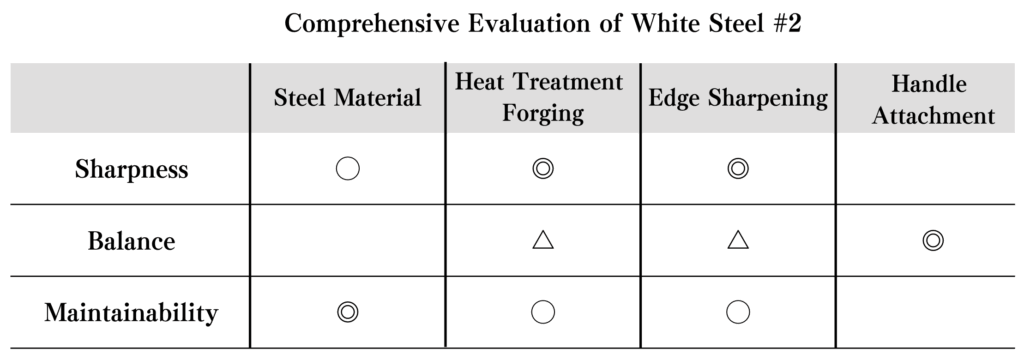
In practical use, White #2 offers excellent sharpness and is relatively easy to re-sharpen, allowing you to maintain a razor edge with minimal fuss. (Its hardness is a bit lower than some ultra-hard carbons, but that trade-off makes it more user-friendly to hone.) Jikko’s blade grinding and edge crafting are highly esteemed, resulting in a superb cutting feel.
Home Cooking Enthusiast Review: “Ever since I started using this White #2 santoku, my daily cooking has become so much smoother. I plowed through a mountain of vegetables during prep, and from morning to night the blade’s sharpness didn’t drop at all—I was amazed. Even when slicing thick carrots, the edge glides straight in, making perfectly even rounds with ease. The White #2 steel sharpens up easily; with just light effort my edge becomes razor sharp again, so upkeep is no burden. Being high-carbon, you do have to mind its susceptibility to rust: I make sure to thoroughly wipe the blade dry after each use and occasionally apply a bit of oil. The traditional wa-handle in wood feels great in hand—secure yet not heavy—and even during long sessions my hand doesn’t tire. This knife truly made me realize “a sharp knife makes cooking this enjoyable!” I don’t even mind the extra care it needs, because it’s such a pleasure to use.)
2nd Place: SG2 和 (R2) Santoku
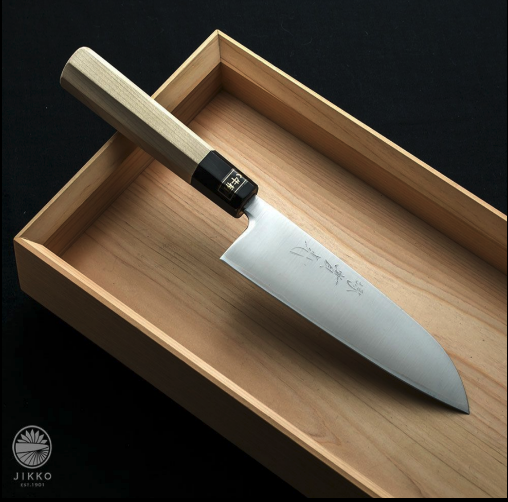
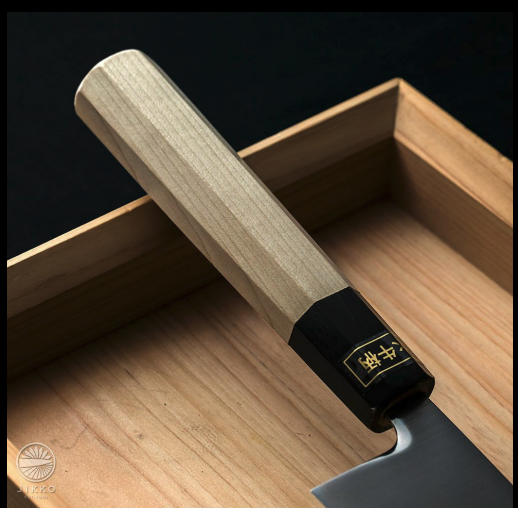
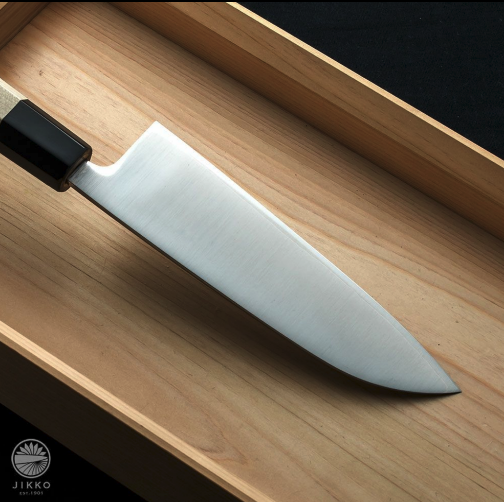
| Aspect | 5-Point Rating |
|---|---|
| Sharpness | ★★★★☆ |
| Edge Retention | ★★★☆☆ |
| Rust Resistance | ★★★★☆ |
| Ease of Maintenance | ★★★☆☆ |
| Aesthetics | ★★★★★ |
| Price | $300 |
This is another santoku from Jikko. As the name suggests, it uses SG2 (R2) powder high-speed steel at its core.
Among stainless steels, SG2 (also called R2) is a top-tier, high-hardness alloy known for achieving extremely sharp edges and excellent edge retention. (See the chart below comparing various stainless steels in terms of sharpness, durability, sharpenability, and rust resistance.)
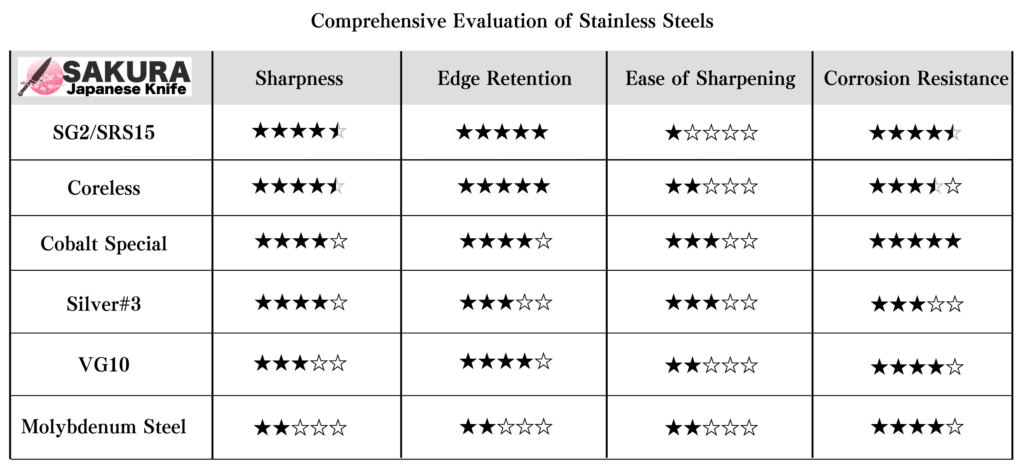
Despite its high hardness, this santoku is made relatively lightweight, making it comfortable for extended use in the kitchen.
Japanese Cuisine Chef’s Review: “When I took this knife out of the box and put it to a cutting board, it felt like the blade just fell through the food – I couldn’t help but exclaim at the incredible sharpness. It slices through even hard kabocha squash with no chipping worries, and it holds its edge through continuous cutting of meat, fish, and veggies. Perhaps it’s the power of the SG2 powder steel, but even after using it daily for three weeks straight, I feel like “I probably don’t need to sharpen it quite yet.” The wa-style wooden handle is light and fits my hand comfortably. The overall weight balance of the knife is exquisite, so even processing large amounts of ingredients doesn’t fatigue my wrist. The blade’s high hardness means I do take care not to be rough on the cutting board or hit bones, to avoid any risk of chipping, but for normal use it’s absolutely fine. I expected such a hard steel might be a pain to sharpen, but to my surprise, when I did touch up the edge, it took on a keen edge more smoothly than I thought it would.)
3rd Place: KAI Seki Magoroku 15000ST Santoku 165 mm
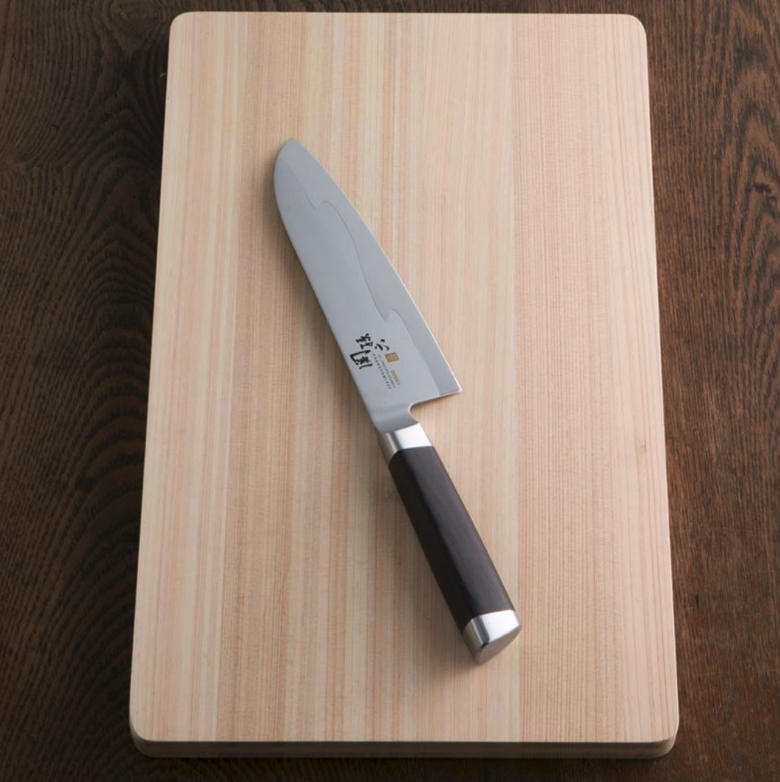
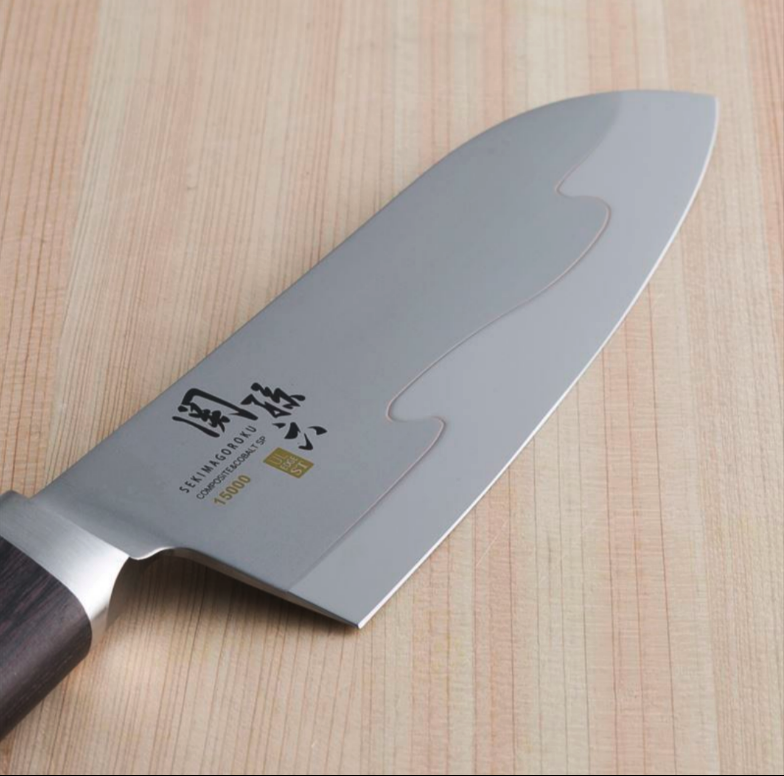
| Aspect | 5-Point Rating |
|---|---|
| Sharpness | ★★★★☆ |
| Edge Retention | ★★★★☆ |
| Rust Resistance | ★☆☆☆☆ |
| Ease of Maintenance | ★★★☆☆ |
| Aesthetics | ★★★★★ |
| Price | $200 |
Seki Magoroku is one of the most famous knife brands in Japan (by KAI). While they primarily market home kitchen knives, they also produce higher-end lines for professionals. The 15000ST Santoku uses a high-carbon stainless steel, which has higher hardness and wear resistance than ordinary stainless, resulting in a knife with very sharp and long-lasting performance.
The trade-off of this high carbon content is that it’s less rust-resistant than typical stainless steel. You’ll need to be diligent about drying it thoroughly and storing it in a low-humidity environment, as it can patina or rust if moisture is left on the blade.
Western Cuisine Chef’s Review: “When I first used this knife, I was astonished: “I can’t believe a knife in this price range cuts this well!” In a test, I tried slicing through a tomato’s thin skin—just placing the blade on it and drawing— and the edge slid right in, making a clean cut so smoothly the tomato didn’t even seem to notice it was being cut! It also zips through chicken skin without catching, making prep work so much easier that I found myself grinning while cooking. The mirror-polished blade is visually stunning, and every time I pick it up in the kitchen I get a little spark of joy from its sleek look. It has a nice heft that provides stability, allowing me to use the knife’s weight to push-cut through hard vegetables smoothly. Truly, I was surprised such an excellent cutter existed at this price point. The moderate weight gives it a steady feel, and when chopping tough veggies, that weight helps drive the blade through effortlessly.)
Petty Knives – Top 3 Recommendations
A Pettyナイフ (petty knife) is a small, lightweight kitchen knife ideal for delicate work like peeling fruits, carving decorative cuts, and other detail tasks.
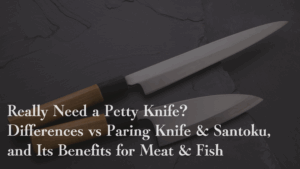
Because of its maneuverability and ease of handling, it’s invaluable for fine work close to the hands. (Note: Being double-edged, the petty knife is categorized as a Western-style knife.)
For each task, different blade lengths of petty knives are considered optimal, roughly as follows:
| Use Case / Task | Suggested Blade Length | Features (Pros & Cons) |
|---|---|---|
| Paring fruit, prep small ingredients | ~90–100 mm | Pros: Very easy to control for precise, delicate work.Cons: May lack sufficient reach for prepping meat/fish. |
| Trimming small cuts of meat or fish | ~120–130 mm | Pros: Versatile length that can handle everything from peeling fruits/veggies to prepping smaller cuts of meat or fish.Cons: Neither extremely short nor long—some might find it a bit middling or “jack of all trades” feeling. |
| Broader prep, slicing small fillets, etc. | ~130–150 mm | Pros: Feels almost like a small gyuto (chef’s knife), allowing a wider range of uses including filleting small fish or removing small bones.Cons: In tight spaces or for very fine work, the longer blade can be harder to maneuver. |
(For a detailed deep-dive into professional petty knives, see our dedicated petty knife article.) Below, we feature the top 3 petty knives highlighted in that article:

1st Place: Jikko (實光刃物) White Steel#2 Petty
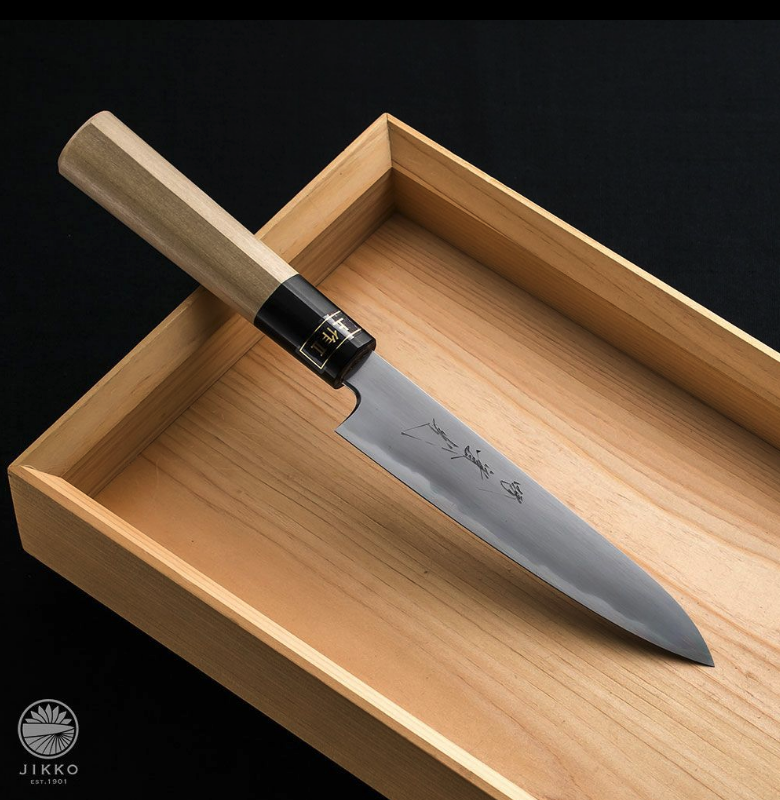
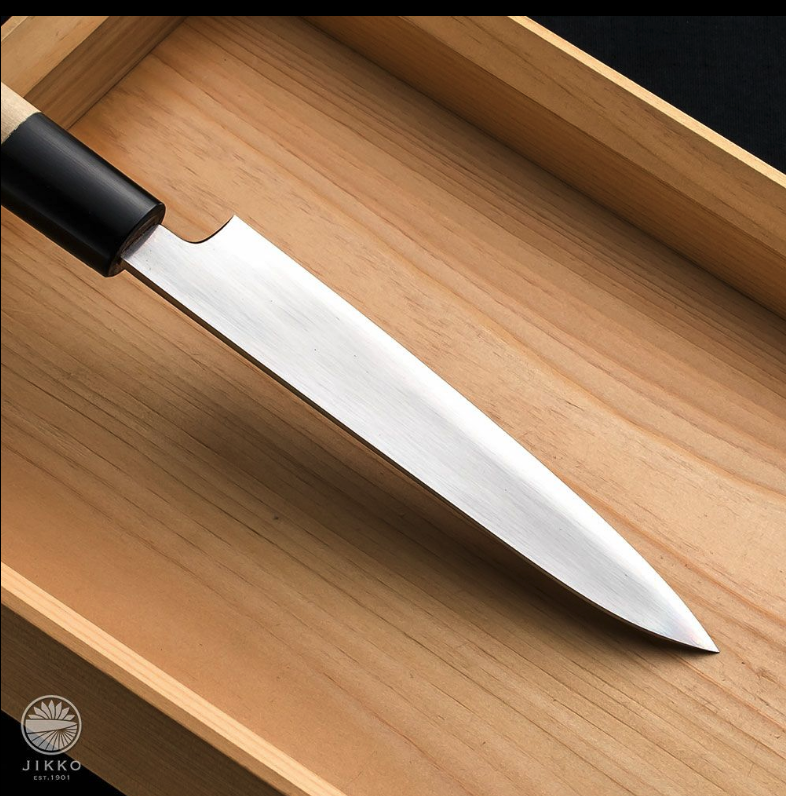
| Aspect | 5-Point Rating |
|---|---|
| Sharpness | ★★★★☆ |
| Edge Retention | ★★★☆☆ (likely ★★★★☆) |
| Rust Resistance | ★☆☆☆☆ |
| Ease of Maintenance | ★★★★☆ |
| Aesthetics | ★★★★★ |
| Price | $350 |
The Shirogami #2 Petty is produced by Jikko (實光刃物), a Sakai-based knife maker founded in 1900 in Osaka—Sakai is a famed cutlery capital, and in fact approximately 80% of professional Japanese cuisine chefs use knives from Sakai. Sakai knives are known as high-end tools favored by pros.
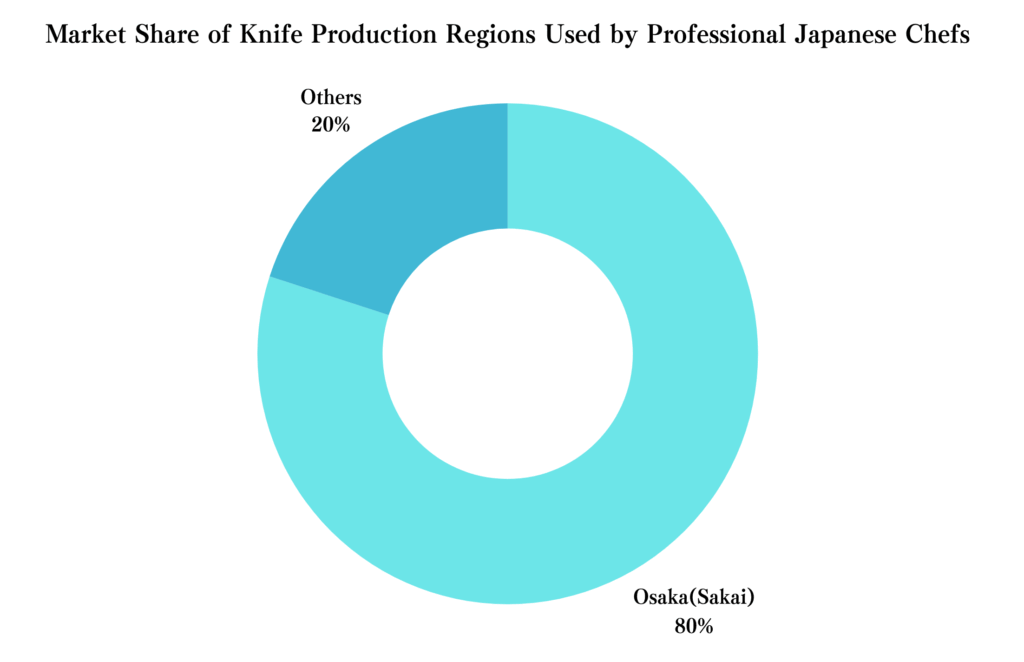
As the name indicates, this petty uses White Paper #2 steel (Shirogami 2) for its blade material, which is the fundamental carbon steel widely beloved by professionals for its balanced performance.
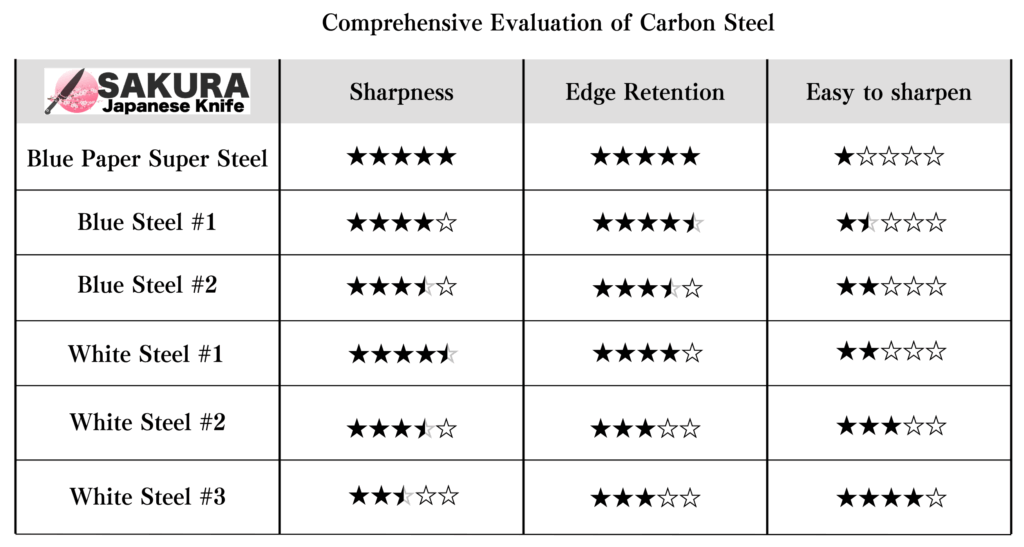
Notably, this petty is a san-mai (tri-layer) construction: the White #2 core is clad in a more flexible stainless steel on each side. This adds toughness and makes the blade less brittle. 【Image: Cross-section of san-mai cladding】 Because only a small exposed portion of the core steel runs along the edge, there’s minimal area that can rust, which greatly improves maintenance. This is essentially a must-have knife for any professional starting their kit.
Despite being technically a Western-style petty knife, it features a handle with a Japanese wa-style aesthetic, giving it a fusion of Western functionality with a traditional look and feel.
Japanese Cuisine Chef’s Review: “This trusty partner has become a star for all the fine tasks. The compact ~15cm blade is perfect for peeling apples, hulling strawberries, and other precise prep. The White #2 steel’s sharpness is incredible—when I found I could peel a tomato without blanching it (the skin just slides off under the blade), I was blown away. It’s lightweight and very well-balanced, so it feels like an extension of my hand, allowing me to execute delicate garnish cuts exactly as I envision. The wa-style handle is slim and easy to grip, which is great for my smaller hands. Over time a faint blue-black patina has developed on the edge (that so-called “kasumi” haze or light rust that carbon steel gets with use), but I actually appreciate it as part of the knife’s character—and with proper care it’s not an issue. I just make sure to wipe the blade dry immediately after each use. Overall, this petty knife brings me so much joy in the kitchen; its sharpness makes every little task effortless. It fits my hand like a glove and has truly become an irreplaceable companion—so much so that I don’t mind the extra care a carbon steel blade needs.)
2nd Place: Yasuda Hamono “Kotetsu” Yasuki Aogami #2 Petty
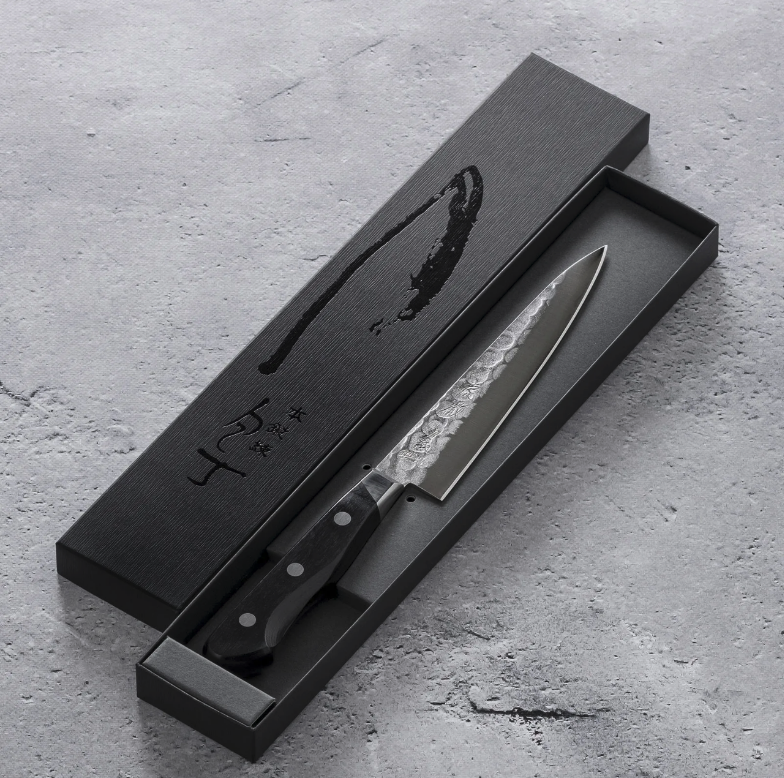
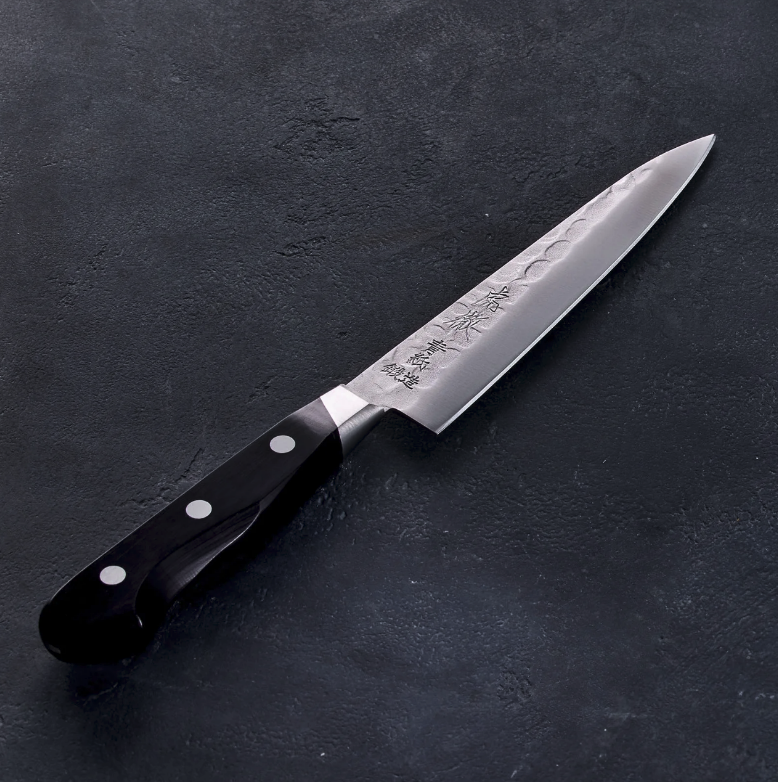
| Aspect | 5-Point Rating |
|---|---|
| Sharpness | ★★★★☆ |
| Edge Retention | ★★★★☆ |
| Rust Resistance | ★★★☆☆ |
| Ease of Maintenance | ★★★☆☆ |
| Aesthetics | ★★★★★ |
| Price | $200 |
Yasuda Hamono is a knife manufacturer based in Seki City, Gifu Prefecture—one of Japan’s premier cutlery centers.
This petty’s blade is made of Blue Paper #2 steel (Aogami #2), which is White #2 steel with tungsten (W) and chromium (Cr) added. (In other words, it’s a higher-alloy carbon steel that retains sharpness longer at the cost of a bit more difficulty in sharpening.)
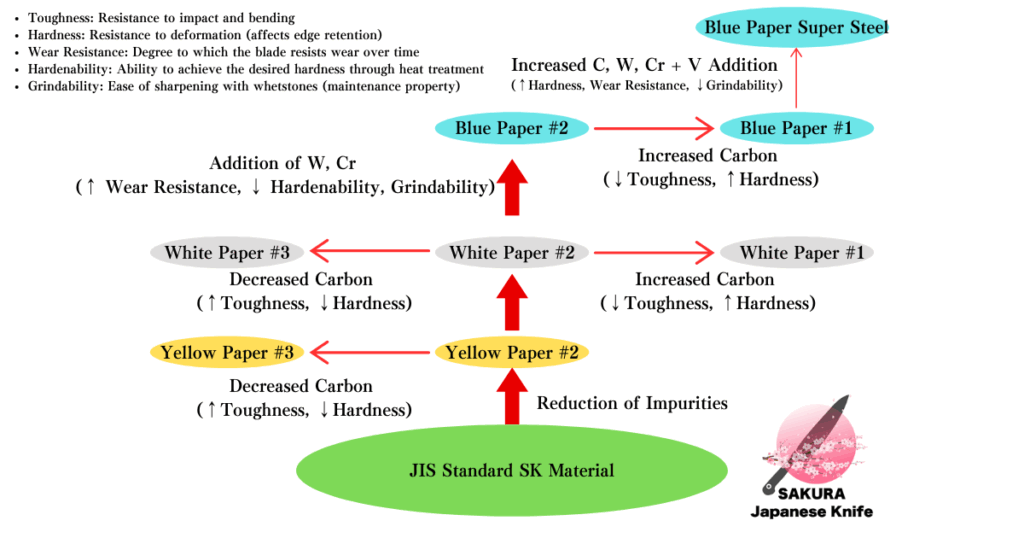
Blue #2 has slightly higher hardness than White #2, and it offers superb cutting power plus extended edge life thanks to those alloying elements.
The knife features a wooden handle with a textured grip finish, providing a stable, non-slip hold—great for long working sessions. It’s a petty designed for professional use, combining sharp performance with comfort.
Japanese Cuisine Chef’s Review: “True to its name, this knife has a powerful, sword-like cutting ability and aura. I have the petty size, but it has an impressive presence—just sitting on the cutting board it makes me think ‘Oh, today’s prep will be a breeze with this sharp blade.’ The characters “虎徹” (Kotetsu) etched on the blade and the hamon-like wavy pattern along the steel are beautiful, giving the sensation of holding a traditional Japanese sword. As expected, the cutting performance is top-notch—thanks to the Blue #2 steel, even hard carrots feel like the blade just glides through with a satisfying snip sound as it cuts. When chopping scallions, the rings practically fly off the blade, it’s so quick and clean. Compared to White steel blades, I notice the edge lasts a bit longer; once I sharpen it, it stays very keen for a considerable time. The weight is just right—though small, it’s very stable and the knife doesn’t wobble at all during use. On the flip side, being high-carbon steel, you do have to watch out for rust: one time I absent-mindedly left a few water droplets on the blade after use and a faint rust film appeared. Now I’ve gotten in the habit of washing and drying it immediately, and I haven’t had any issues since. I think this knife is a gem for those who prioritize sharpness, and also love a cool traditional design. It really elevates the fun of cooking; I’d call it a masterpiece that highlights the joy of using a fine tool.)
3rd Place: Sakai Ichimonji Mitsuhide FV10 Tamatsuke Petty Knife

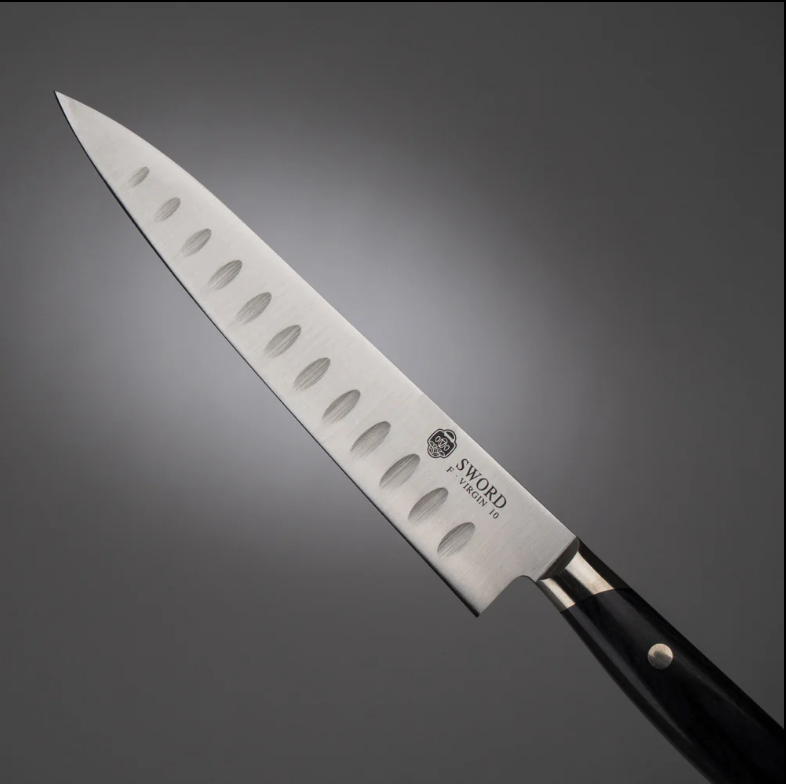
| Aspect | 5-Point Rating |
|---|---|
| Sharpness | ★★★☆☆ |
| Edge Retention | ★★★★☆ |
| Rust Resistance | ★★★★★ |
| Ease of Maintenance | ★★★☆☆ |
| Aesthetics | ★★★★☆ |
As the name suggests, Sakai Ichimonji Mitsuhide is a Sakai, Osaka-based knife maker. This petty uses V-Kin-10 (VG10) stainless steel, a highly regarded steel known for a well-balanced combination of sharpness, edge retention, wear resistance, and ease of sharpening.
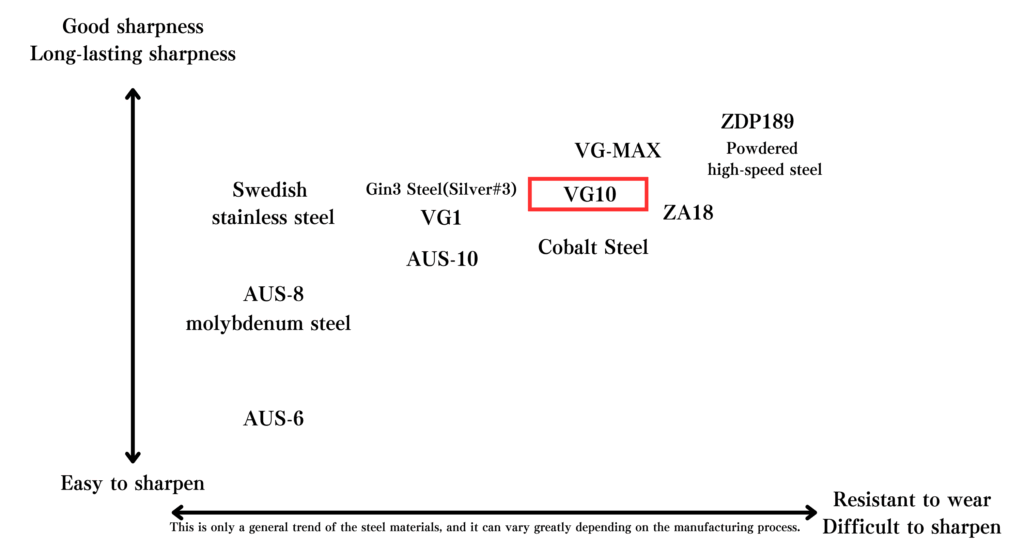
While a carbon steel like White #2 can achieve an even keener edge, VG10 still offers plenty of sharpness—more than enough for most tasks—and has the big advantage of being stainless. This makes it ideal for those who don’t want to spend much time on maintenance.
Japanese Cuisine Chef’s Review: “Don’t let its small size fool you—this knife packs professional performance. The first thing I noticed when picking it up was its light weight and superb balance; it has a presence that doesn’t feel like a mere 12–15cm petty. With high-end VG10 stainless at its core, I was genuinely surprised by how effortlessly it could peel tomato and grape skins—the blade is extremely keen. The thin, finely honed blade feels like I’m using a traditional wa-bocho (Japanese knife) in terms of delicate cutting ability. I tried slicing sashimi blocks with it in a single stroke and, incredibly, it yielded clean sashimi cuts — I found myself thinking “I can do such delicate work with a petty knife!” The steel is very hard, but since each blade is hand-finished by a skilled sharpener (with a Tamatsuke mirror-polish and edge), it’s surprisingly smooth to resharpen—almost like sharpening carbon steel. And being stainless, it’s highly rust-resistant — even after cutting lemons, not a single spot formed on the blade. It’s as if I have the precision of a yanagiba in petty knife form, with none of the rust worries. Truly, this petty knife combines the best of both worlds: traditional Japanese precision and modern convenience. I found that even fine tasks like pulling delicate sashimi slices or removing small fish bones were achievable with it, which is astounding for a petty. The handle’s polished tamagane (jewel steel) finish and perfect octagonal shape fit my hand like it was custom-made, and after long use I felt no fatigue. If you want a petty that performs like a mini sashimi knife, this is it. There’s virtually no maintenance hassle thanks to the stainless steel, and the edge comes back easily on stones. Overall, it’s an ideal choice for those who want a petty knife that’s both beautiful and incredibly functional.)
Deba Knives – Top 3 Recommendations
In Japanese cuisine, fish play a big role, so there are many knives specifically for fish. Among them, the Deba包丁 (deba knife) is a thick, heavy knife indispensable for butchering fish in washoku (Japanese cooking).
Deba have wide blades and substantial weight, which provides stability and leverage when cutting through fish heads and bones. They are suitable for tasks like filleting fish (san-mai oroshi), cutting fish into sections, and other fish butchery. Typically they are single-beveled, designed to cut cleanly through bone with minimal resistance.
(For those interested, see our article on how to use a deba knife and how it differs from other knives.) One key point: you should choose the deba’s blade length according to the size of fish you’ll handle. Here is a general guideline:
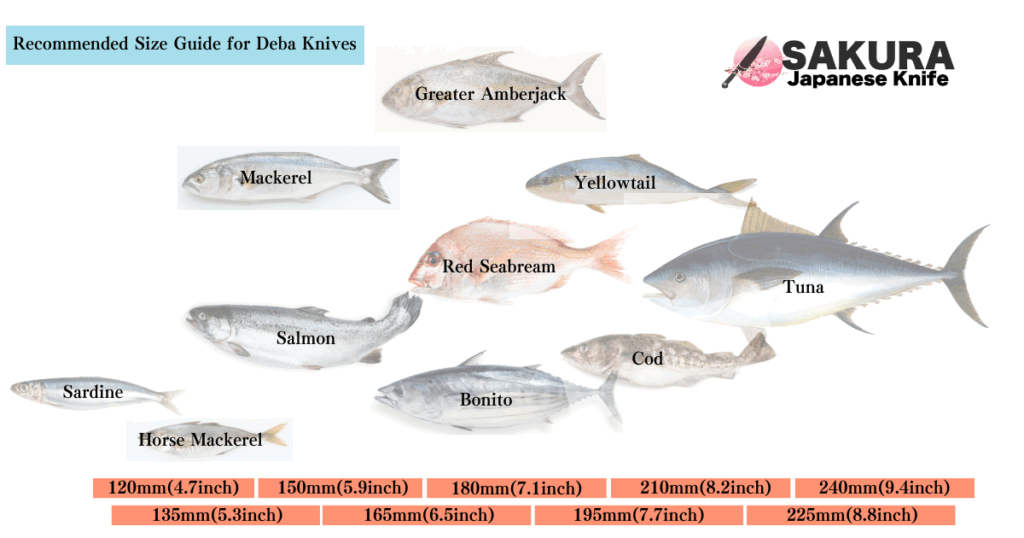
For more on professional deba knives (including ko-deba), see our detailed article. Below, we feature the top 3 deba picks from that article:
1st Place: Jikko (實光刃物) White Steel#2 Deba
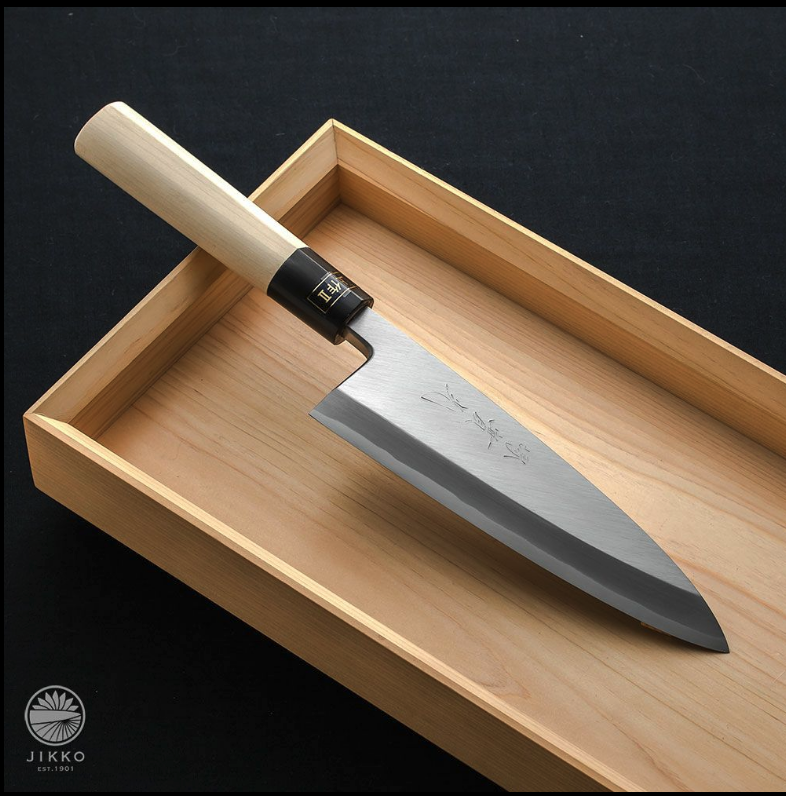
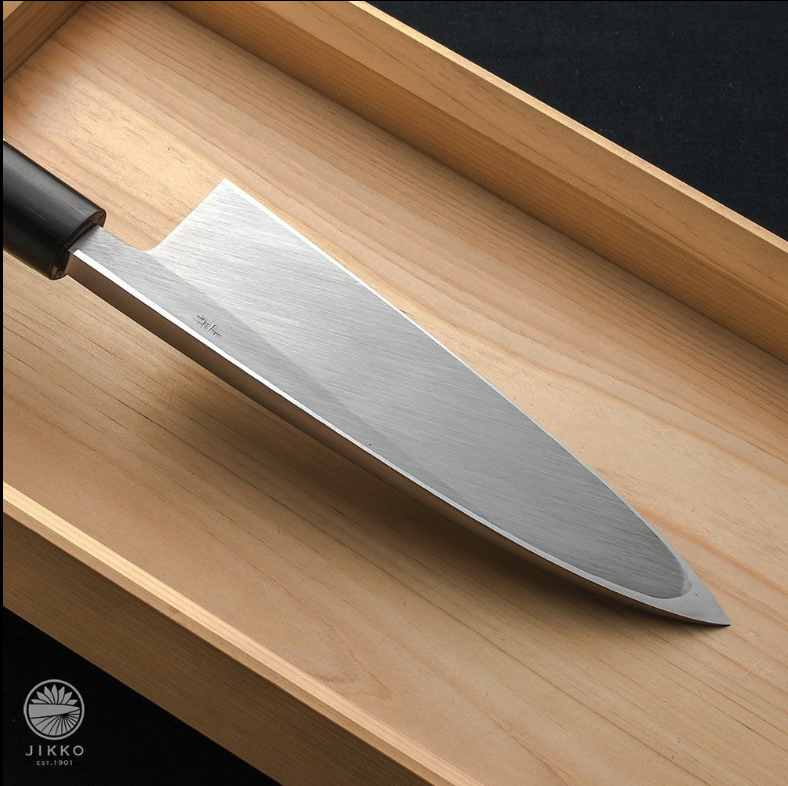
| Aspect | 5-Point Rating |
|---|---|
| Sharpness | ★★★★☆ |
| Edge Retention | ★★★☆☆ |
| Rust Resistance | ★☆☆☆☆ |
| Ease of Maintenance | ★★★★☆ |
| Aesthetics | ★★★★★ |
| Price | $600 |
This Sakai-made deba by Jikko, using White #2 steel, is a knife we can recommend to virtually any professional. White #2, as noted earlier, is one of the most well-balanced carbon steels and is the most widely adopted steel among professional chefs.
Because White #2 is a very pure carbon steel with minimal impurities, it can attain extremely sharp edges. The blade gets incredibly razor-fine, making it ideal for precise work and clean cuts—perfect for a professional setting.
The knife is single-bevel (as most deba are), but it’s a kasumi deba: the front side is hard steel and the back side is a softer iron. This adds some flexibility and makes sharpening easier. Also, since only the back side (ura) uses White #2, only that side is prone to rust, whereas the softer clad front side is less rust-prone, making maintenance easier. This is a big advantage in daily use.
Another strength: Jikko offers this deba in a wide range of blade lengths. Whether you need to fillet small horse mackerel or break down a tuna, you can find an appropriate size in this lineup.
For reference, here is a list of available lengths and prices for this White #2 deba series:
| Blade Length | Price (incl. tax) |
|---|---|
| 105 mm | ¥24,530 |
| 120 mm | ¥26,840 |
| 135 mm | ¥28,050 |
| 150 mm | ¥32,560 |
| 165 mm | ¥34,650 |
| 180 mm | ¥38,940 |
| 195 mm | ¥44,440 |
| 210 mm | ¥51,920 |
| 225 mm | ¥61,600 |
| 240 mm | ¥73,150 |
| 270 mm | ¥107,470 |
| 300 mm | ¥154,770 |
This deba enjoys a great reputation among Japanese cuisine chefs, and it’s safe to say it’s a versatile, go-to knife for professionals.
Japanese Cuisine Chef’s Review: “The first time I filleted a large tai (sea bream) with this knife, I was shocked by how different it felt compared to my previous knives. When I set the hefty blade against the backbone and leaned in with my weight, there was a satisfying “meri” crunch as it cut cleanly through the bone – the feedback was incredible. The heavy blade, once you put your weight on it, bites through fish bones with a pleasing ease. The White #2 edge is extremely sharp, so when pulling the blade to slice fish flesh off the bone, it glides through and leaves a smooth, glossy cut surface. Even when chopping off the fish’s head, the knife felt very stable; it enters exactly where I aim, with no blade wander, eliminating any fear or struggle. It’s quite hefty, but that weight actually works in your favor – you let the knife’s mass do the work cracking hard bones, meaning you don’t need to swing or force it, which is nice. Being a single-bevel wa-bocho, I had to adjust my sharpening technique initially, but the blade is thick and robust, so it was quite forgiving – even if my sharpening angle was a bit inconsistent, it still maintained plenty of cutting power. Overall, this deba made filleting fish feel safer and more efficient. The fact that I don’t have to whack or use excessive force (thanks to its weight) is a huge plus. Truly a reliable, all-around deba for pros.”
2nd Place: Youshihiro (Gō-umarujō Yoshihiro) “Aoka” Blue #2 Deba with Magnolia Octagonal Handle
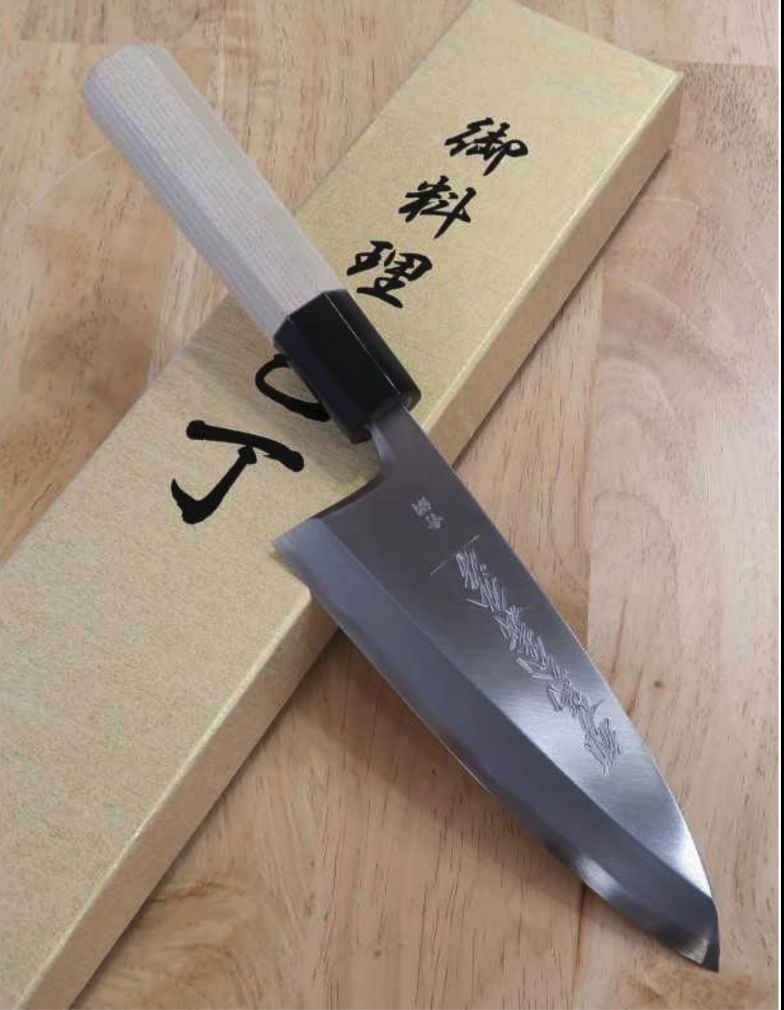
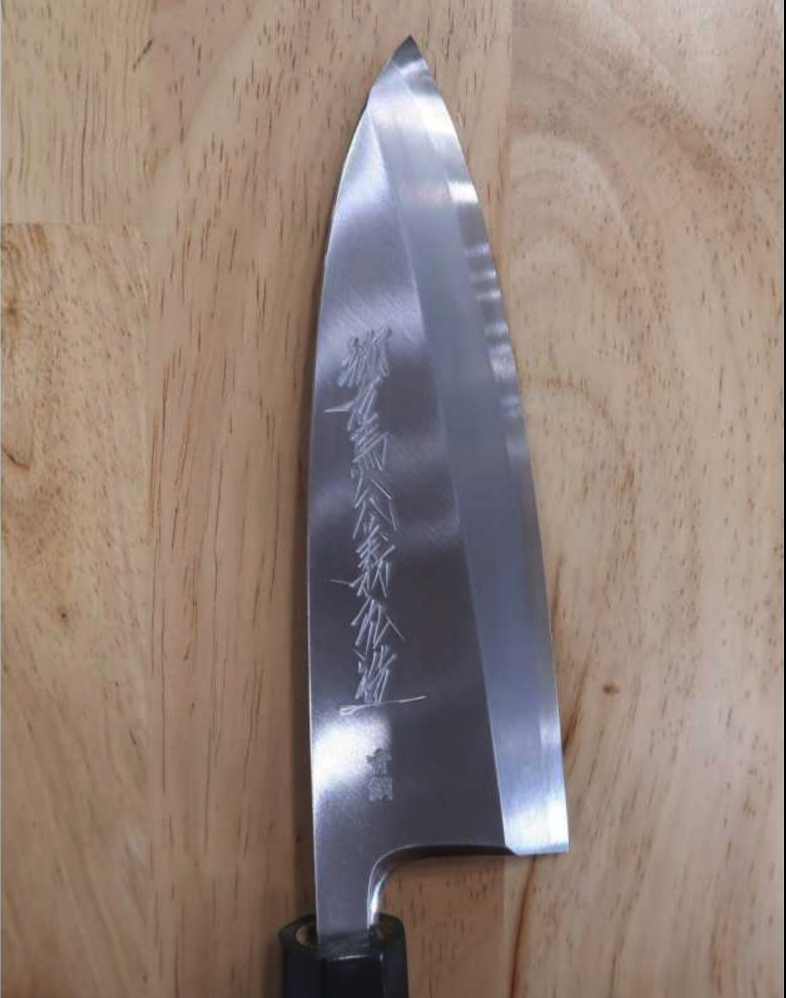
| Aspect | 5-Point Rating |
|---|---|
| Sharpness | ★★★★☆ |
| Edge Retention | ★★★★☆ |
| Rust Resistance | ★☆☆☆☆ |
| Ease of Maintenance | ★★★☆☆ |
| Aesthetics | ★★★★★ |
This knife is sold by Yamawaki Hamono in Sakai. The brand name “Gō-umarujō Yoshihiro” actually comes from a famous Kamakura-period swordsmith; it’s one of the brands they use for their knives.
The blade uses Blue Paper #2 steel, which compared to White #2 holds an edge longer (higher wear resistance) at the cost of being a bit harder to sharpen. This makes it well-suited for those who have to do long butchering sessions, as it stays sharp throughout heavy use.
They offer this deba in three sizes: 150mm, 165mm, and 180mm. Note: They do not offer a very small ko-deba size in this line (nothing under 150mm), as the range starts at 150mm and goes up. So it’s intended more for medium to larger fish.
The available sizes and prices are:
| Blade Length | Price (incl. tax) |
|---|---|
| 150 mm | ¥36,410 |
| 165 mm | ¥42,570 |
| 180 mm | ¥47,850 |
Seafood Market Chef’s Comments: “This knife shines when breaking down large quantities of fish and meat. It offers a combination of razor sharpness and high durability, so even during extended prep sessions the edge holds up great—meaning you rarely need mid-task touch-ups.
The well-balanced, easy-to-grip design fits my hand nicely and helps prevent fatigue despite the knife’s heft. In practice, it allows precise yet powerful cuts when prepping fish or meat, making it a trustworthy tool in a pro kitchen.
Its robust build can endure the harsh daily conditions of a busy prep environment, which is a huge plus. In short, for a professional who processes a lot of fish or meats, this deba delivers optimal performance and reliability day in and day out. The sturdy construction means it’s built to withstand rigorous use while still performing at a high level.”

3rd Place: Sakai Takayuki Chef Series Gin-San (Silver #3) Deba
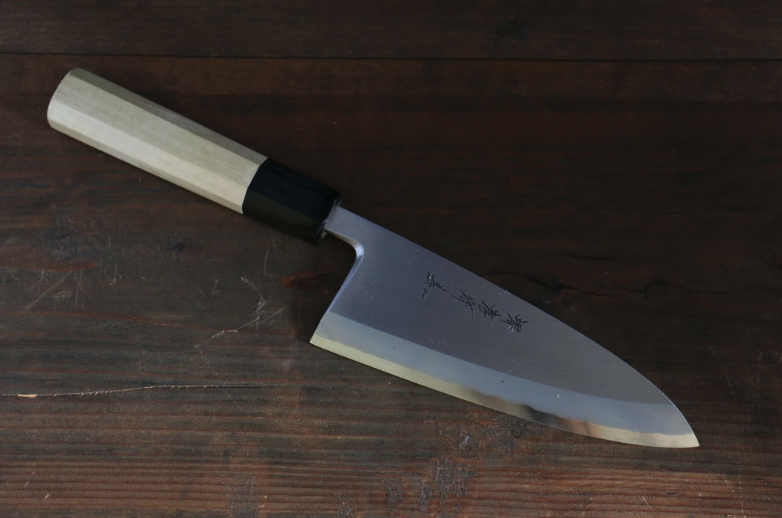
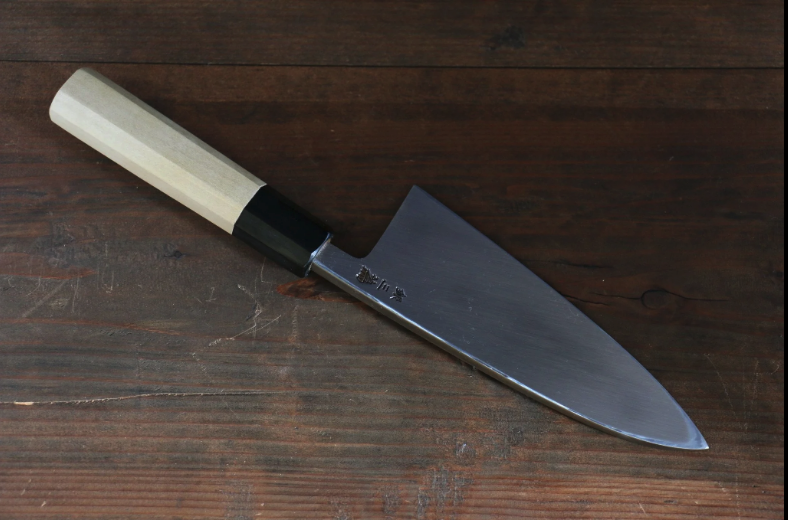
| Aspect | 5-Point Rating |
|---|---|
| Sharpness | ★★★☆☆ |
| Edge Retention | ★★★★☆ |
| Rust Resistance | ★★★☆☆ |
| Ease of Maintenance | ★★★★☆ |
| Aesthetics | ★★★☆☆ |
The first two debas above use carbon steel cores, but this one uses Gingami No.3 (Silver #3) stainless steel – a popular high-end stainless for traditional knives. Silver #3 offers a very balanced profile: not as extreme in sharpness as carbon steel, but it strikes a great balance of edge retention, sharpening ease, and sharpness.
It’s a stainless steel that many professionals appreciate for its low maintenance and reliable performance. Additionally, this Chef Series deba comes in a wide array of sizes, so you can select a blade length that matches the fish you typically handle.
The lineup’s blade lengths and prices are:
| Blade Length | Price (incl. tax) |
|---|---|
| 105 mm | ¥40,800 |
| 120 mm | ¥44,400 |
| 135 mm | ¥48,000 |
| 150 mm | ¥51,600 |
| 165 mm | ¥56,400 |
| 180 mm | ¥66,000 |
| 195 mm | ¥74,400 |
| 210 mm | ¥82,800 |
| 225 mm | ¥97,200 |
| 240 mm | ¥108,000 |
Fishmonger’s Review: “I had been wishing for a deba that won’t rust easily, and this knife delivered. It may not have the dramatic appearance of some traditional carbon steel debas, but in use it absolutely surprised me with its practicality. Made of Gingami No.3 stainless (Ginsan steel), after filleting a red sea bream and a grunt fish, I saw almost no oxidation on the blade—indeed, after washing and a quick wipe, it stayed spotless. I processed several fish for sashimi back-to-back, and all it took was a rinse and dry between tasks to keep it in great shape. The sharpness is on par with carbon steel debas; when I slide the edge along the spine, the fillet lifts off as cleanly as with my White steel knife. It even cut through tough pin bones easily at the tip, yet interestingly I didn’t experience any edge chipping. Perhaps that’s thanks to Ginsan’s hardness being well-calibrated for a stainless. In terms of weight, it feels like a classic deba – hefty and solid in the grip, providing confidence and stability. I love that I can focus on technique and speed without worrying about immediate rust or constant wiping. For a busy environment, that’s invaluable. Overall, this deba offers that “no-fuss” reliability: it’s sharp, robust, and much more carefree in maintenance than a carbon steel equivalent, which makes it a perfect workhorse for a pro setting where efficiency and cleanliness are paramount.”
Sashimi Knives (Yanagiba) – Top 3 Recommendations
A Sashimi包丁 (Yanagiba knife) is a long, thin, single-bevel Japanese knife primarily used for slicing raw fish for sashimi. It’s characterized by an extremely sharp edge and the ability to make silky-smooth cuts without damaging the fish’s flesh, yielding beautiful presentation.
(For background, see our article on what a sashimi/yanagiba knife is and whether you need one.) While the ideal size of a yanagiba can vary depending on the fish, generally 240–270 mm is common for home use, and 270–300 mm is typical for professional use.
Below, we feature the top 3 sashimi knives for professionals from our detailed rankings (which also cover options for beginners through pros):
1st Place: Gion Haku Kiritsuke-Yanagiba
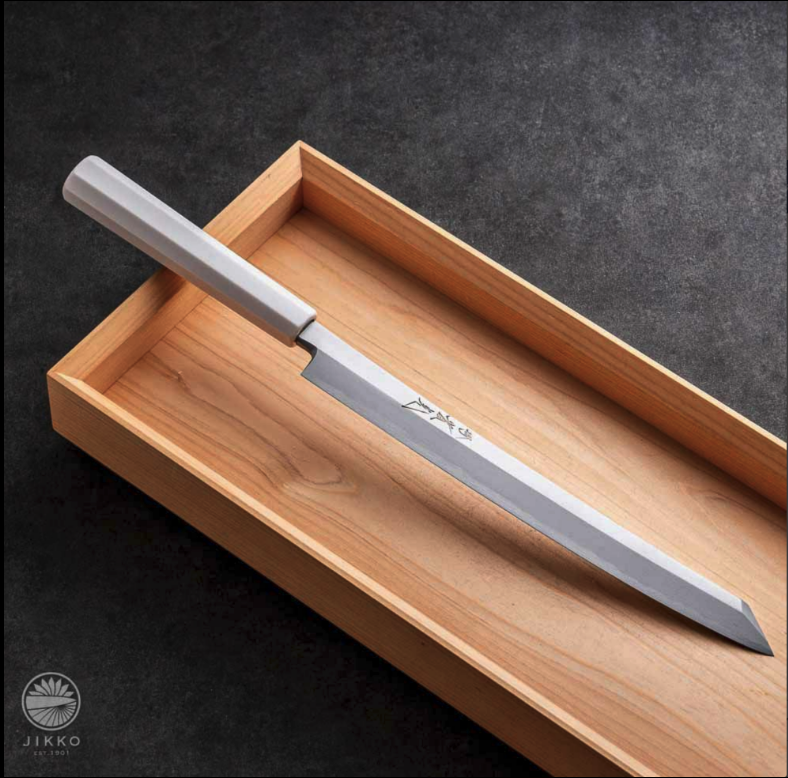
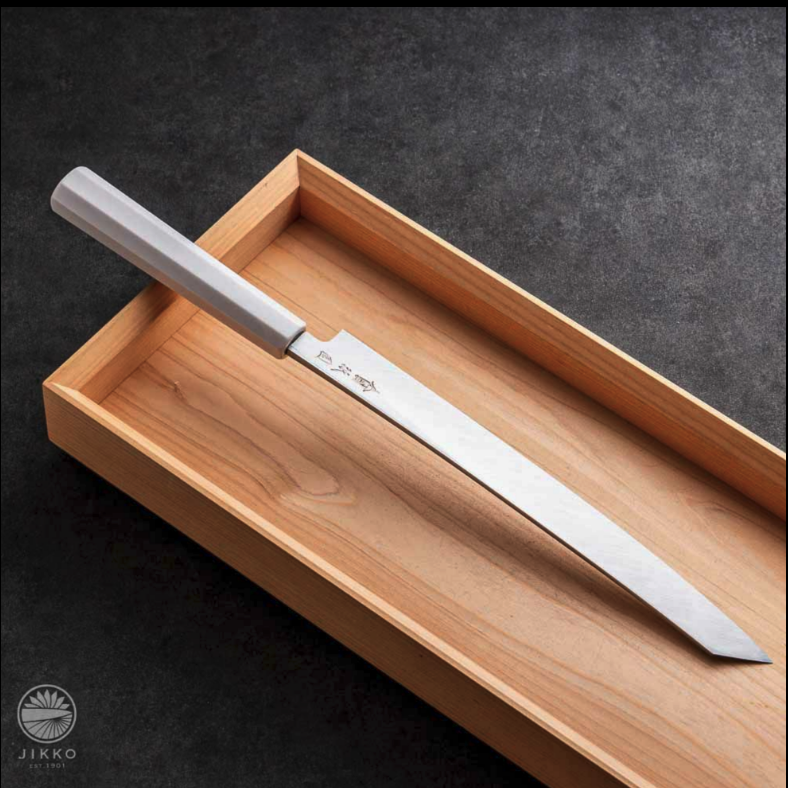
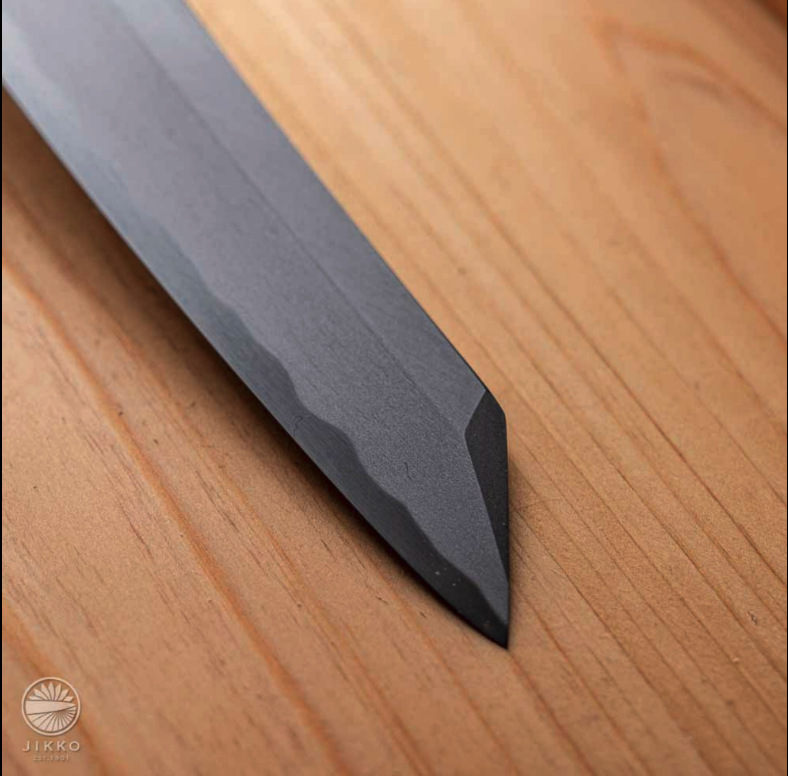
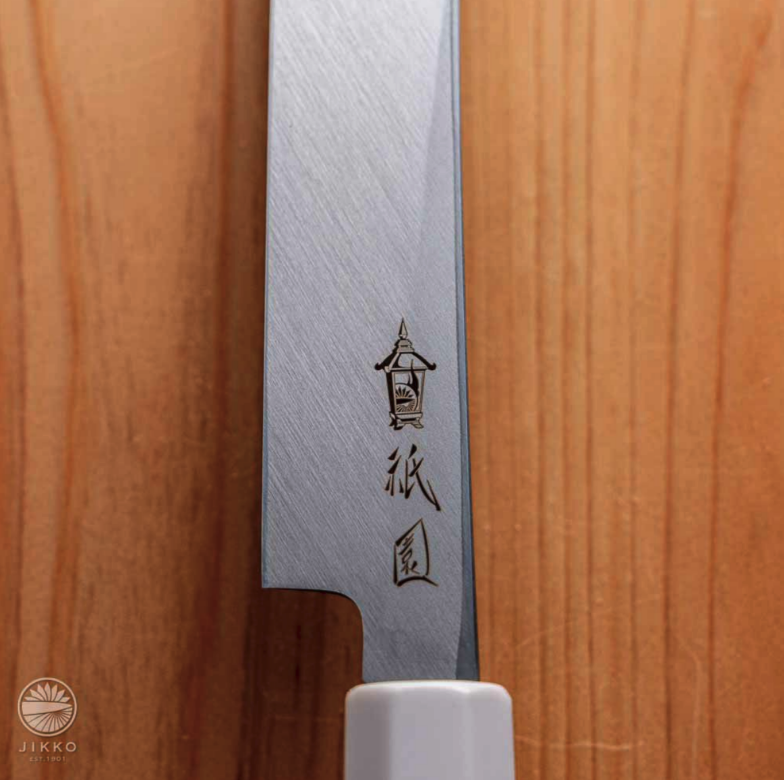
| Aspect | 5-Point Rating |
|---|---|
| Sharpness | ★★★★☆ |
| Edge Retention | ★★★☆☆ |
| Rust Resistance | ★☆☆☆☆ |
| Ease of Maintenance | ★★★★☆ |
| Aesthetics | ★★★★★ |
| Price | $1,200 |
This knife, nicknamed “Gion Haku,” is a kiritsuke-tipped yanagiba (meaning the tip is clipped to a k-tip shape). It’s made by Jikko (實光刃物) in Sakai using White #2 steel and finished in a kasumi style (hard steel with soft iron cladding).
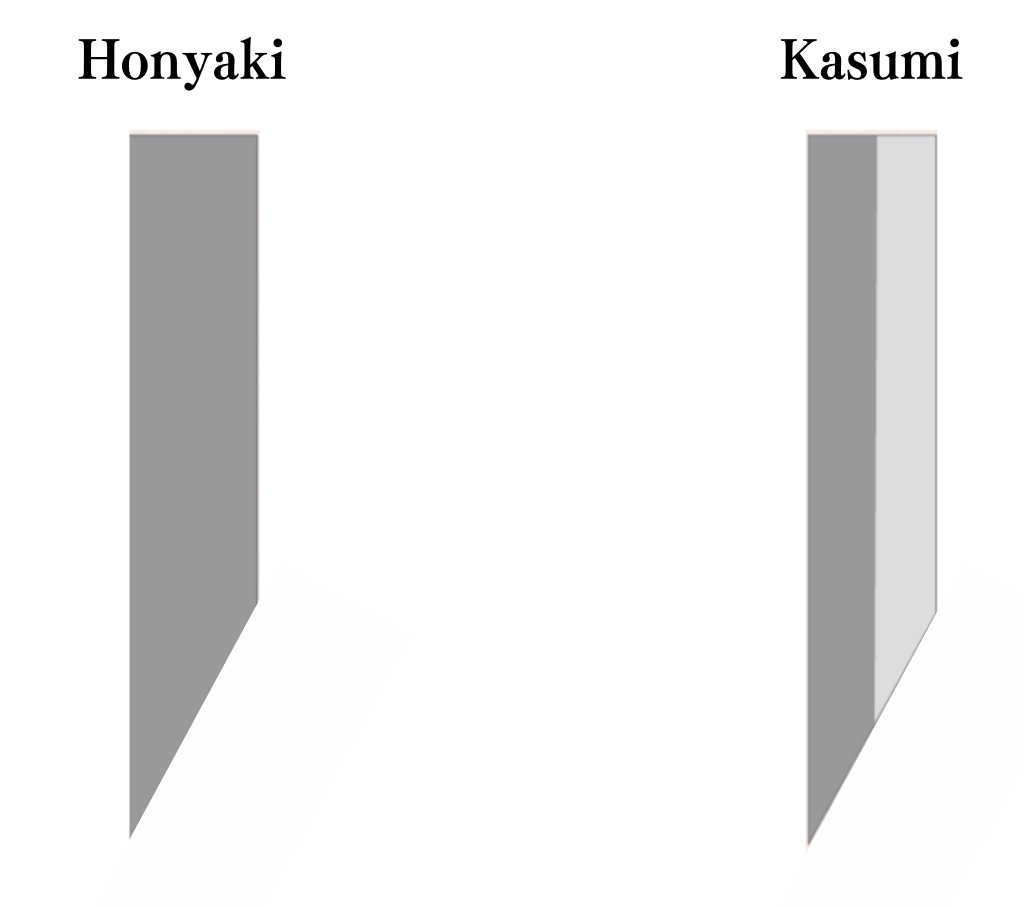
In Japan, White #2 is the steel most widely favored by chefs for yanagiba, so it’s fitting that this blade uses it and is meticulously crafted by Sakai artisans.
The kiritsuke-style tip (basically a yanagiba with the tip squared off at an angle) has a practical benefit: it makes it a bit easier to place the tip precisely at the start of a cut, giving very smooth initiation when pulling through sashimi. (Essentially, the angled tip can help in certain cutting techniques for sashimi.)
This is a top-quality knife with an extremely sharp edge plus a good balance of durability and ease of sharpening, so many professionals love it.
It’s worth noting that honyaki yanagibas (made of one piece of steel) are rare, extremely expensive, and not very practical for most—this knife being kasumi (iron + steel) is a more realistic and user-friendly choice.
(See image: The Gion Haku kiritsuke-yanagiba is a kasumi knife.) The soft iron outer layers mean that aside from the edge, much of the blade surface is less prone to rust, and sharpening is a bit easier than a full steel blade, all while retaining the high performance of the White #2 cutting edge.
Sushi Chef’s Review: “Thanks to the kiritsuke-style tip (essentially a yanagiba with the tip cut to a k-tip), I find it easier to aim the blade tip accurately when starting a sashimi slice, and the initial cut-in feels very smooth. In practice, when I drew this knife through a block of tuna to cut sashimi, the tip entered with zero hesitation and one clean pull yielded a slice with a glistening surface. The ultra-sharp White steel edge cuts without crushing any fibers, so the fish slices release effortlessly from the loin. Despite the long blade, the kiritsuke shape shifts a bit of weight away from the tip, giving it great overall balance and maneuverability. It’s nicely weighted; as I pull the knife, the mass provides stability to get a straight, clean cut every time. The traditional wooden wa-handle fits snugly in my hand and doesn’t cause pain even in prolonged use. If I had to mention a drawback, it’s the susceptibility to rust and the delicacy of the edge. I did notice once that after slicing fish, some soy sauce got on the blade and I left it unwiped briefly—soon a slight dark patina appeared. Since then I’ve been almost overly diligent about wiping the blade immediately. But honestly, that’s expected with high-carbon steel and is a small trade-off for the phenomenal performance. All in all, this knife has become the centerpiece of my kit for its stunning looks and incredible cutting ability. The extra care it needs is well worth it.)
2nd Place: KAI Seki Magoroku Blue Steel #2 Yanagiba
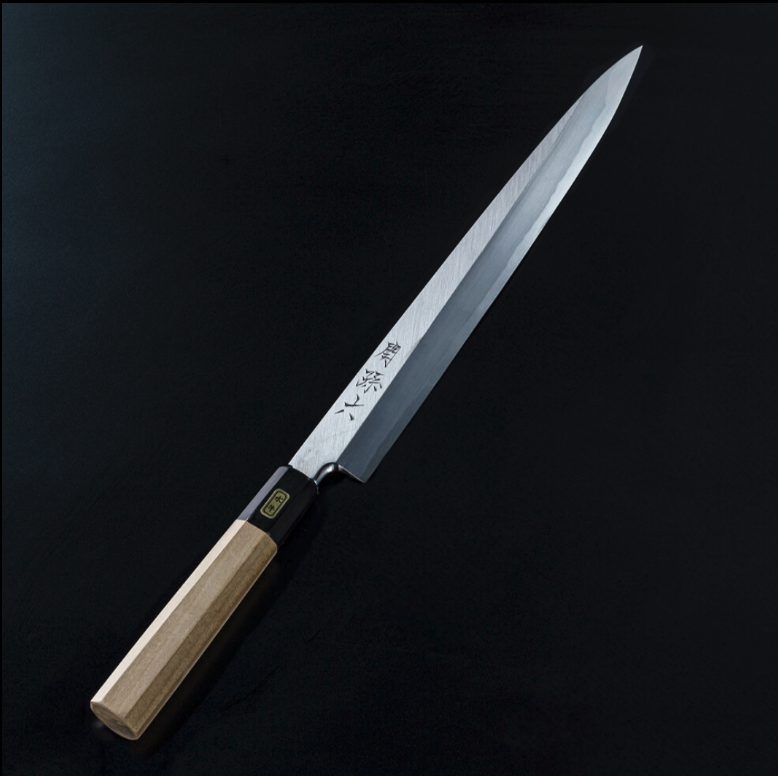

| Aspect | 5-Point Rating |
|---|---|
| Sharpness | ★★★★☆ |
| Edge Retention | ★★★★☆ |
| Rust Resistance | ★★★☆☆ |
| Ease of Maintenance | ★★★☆☆ |
| Aesthetics | ★★★★★ |
This is a sashimi knife from the well-known Seki Magoroku line by KAI – one of the most recognized knife brands. Each knife is finished meticulously by skilled craftsmen.
The blade uses Aogami #2 (Blue Paper #2 steel). Blue #2 adds alloying elements (like tungsten and chromium) to White #2, allowing the blade to hold its sharp edge longer. This makes it an optimal choice for chefs who spend long hours slicing fish in a day, as it can go longer between touch-ups.

Japanese Cuisine Chef’s Review: “This sashimi knife exudes confidence, being a combination of a storied brand and a serious steel. The 240mm yanagiba I received has a beautifully imposing long blade, and you can almost feel the spirit of the craftsman in it. The Blue #2 steel edge comes with a proper honbāzuke (final sharpening) done by a craftsman at the factory; when I tried slicing sashimi with it on the day it arrived, I was blown away by the sharpness. Just placing the blade on a block of fish and drawing it through yielded a cut so smooth the surface shone like a mirror. Even on a soft fish like fugu (pufferfish), it made transparently thin slices without any tearing—truly impressive ultra-thin cuts. The handle has a buffalo horn bolster, giving it that high-end wa-knife aura and durability. In use, even working with wet hands, the handle stayed completely tight with no wiggle, which gave me great confidence. Being Blue steel, it’s also notably easy to sharpen; on the whetstone, you can really feel the edge coming back keenly, which is satisfying. For me, this knife marries the trust of a venerable brand with the performance of a top-tier steel, and it absolutely delivers in a professional setting—long, smooth slicing with edge life that keeps up through service.”
3rd Place: Sakon “Ryuga” Single-Bevel Yanagiba (SRS15 Powder Steel)
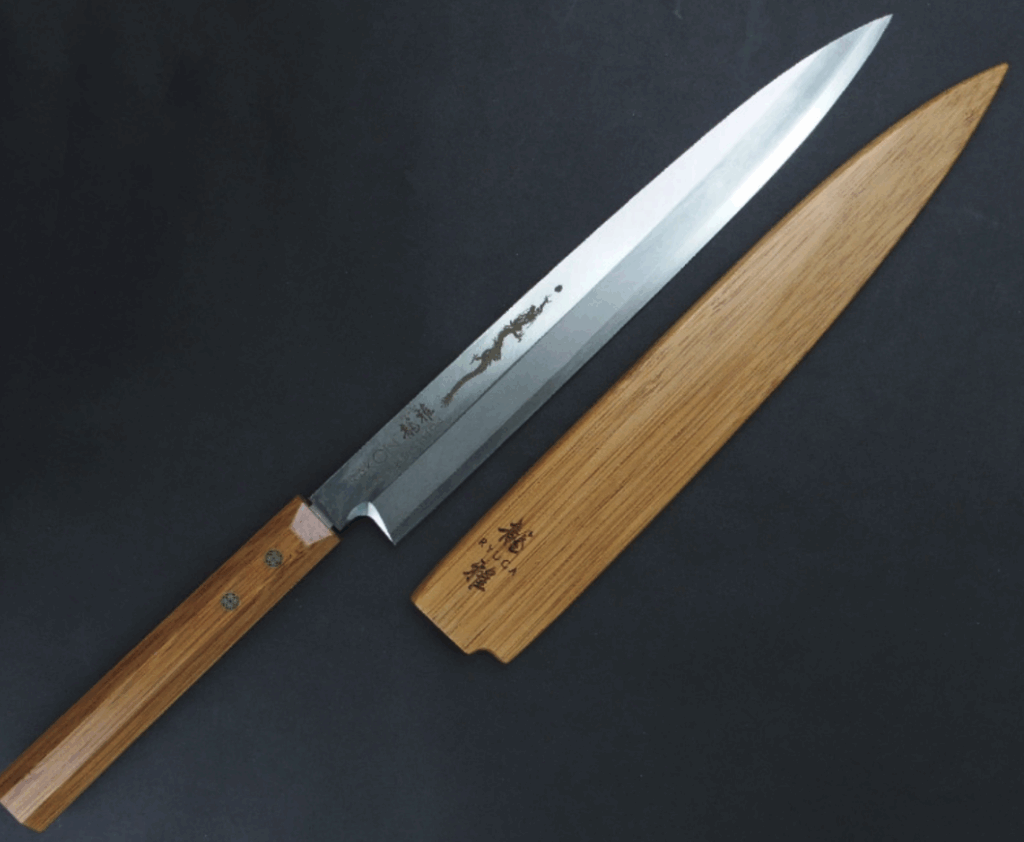
| Aspect | 5-Point Rating |
|---|---|
| Sharpness | ★★★★☆ |
| Edge Retention | ★★★★☆ |
| Rust Resistance | ★★★★☆ |
| Ease of Maintenance | ★★★☆☆ |
| Aesthetics | ★★★★★ |
| Price | $1,000 |
This knife, the Sakon Ryuga yanagiba, uses a high-speed powder stainless steel called SRS15 for its core. SRS15 is known for very high hardness and superb edge retention, though it’s a bit more challenging to sharpen compared to simpler stainless steels.
In comparison to other stainless options: it’s slightly harder to sharpen than Ginsan (Silver #3), but it excels in durability—its wear resistance is on par with or even above VG10. In practical terms, SRS15 was chosen to prioritize sharpness, edge durability, and corrosion resistance. While sharpening is more difficult, with proper technique (and the right stones) it’s manageable.

If you need maximum cutting performance and don’t mind a higher sharpening difficulty, SRS15 is an excellent choice. Once you master sharpening it correctly, it’s not an issue.
Japanese Cuisine Chef’s Review: *“This is a unique knife that feels like a fusion of traditional yanagiba design with cutting-edge steel technology. At first glance it looks like a standard yanagiba, but knowing it has SRS15 powder steel at its core, I was very intrigued to try it. The first thing that amazed me was the edge retention. I processed one block of tuna, one of salmon, one of tai, consecutively for sashimi — and the blade stayed as razor-sharp on the last cut as it was on the first. Normally with White or Blue steel yanagibas, I might consider a light resharpening during such a session, but with this knife I felt no drop in sharpness at all. The hardness of the steel is clearly keeping the edge from dulling. Yet when I did put it to the whetstone, I was doubly surprised by how surprisingly easy it was to sharpen. I was bracing for difficulty since it’s a powder steel, but the edge responded smoothly to the stone, and I could get a refined edge without much struggle. In use, the cutting feel is what I’d call “silky.” Slicing through fish, it’s incredibly smooth, with virtually no resistance—a truly pleasant sensation. It’s like the blade just glides through and the fish falls away.
In terms of build, it feels like a classic yanagiba in weight and balance. So handling it is familiar, but the performance is elevated. I did also appreciate that despite being a high-hardness stainless, rust was a non-issue; even after cutting something acidic like vinegared fish or leaving it a moment, I saw zero staining.
For anyone who values a long-lived edge and low maintenance but still wants that ultra-sharp “pull-cut” experience of a yanagiba, this knife is exceptional. It stays sharp unbelievably long, and while you do need proper technique to sharpen SRS15, it’s well worth it. It truly felt like I was using a “silky touch” blade—smooth, sharp, and effortless. One note: you do need enough skill and space to wield a 300mm blade effectively, but if you have that, this knife will greatly enhance your efficiency and enjoyment.”*
Gyuto Knives – Top 3 Recommendations
A Gyuto包丁 (gyuto knife) is essentially the Japanese take on the Western chef’s knife. Developed from European chef’s knives introduced in the Meiji era, gyutos have since been refined by Japan’s superb knife-making culture. They particularly shine in meat preparation and processing larger ingredients.
Below, we’ve detailed a comprehensive chart of gyuto characteristics, from basic features beginners should know, to advanced qualities that pros look for:
(The table below might be scrollable on smaller screens.)
| Item | Examples / Details | Merits (Pros) | Cautions (Cons) |
|---|---|---|---|
| Blade Steel | – Stainless Steels (e.g. AUS-10, VG10, molybdenum steel, etc.) → Common in mass-market brands like Misono, Seki Magoroku (KAI); relatively easy maintenance.– Carbon Steels (e.g. Shirogami/White, Aogami/Blue, Gingami#3, etc.) → Often used in high-end lines by Sakai Takayuki and other artisan makers. | – Stainless: Resists rust, easy daily care. Generally approachable for beginners.– Carbon: Capable of extremely sharp edges; very satisfying to sharpen for a “pro-level” edge feel. | – Stainless: Edge might not last quite as long as carbon, and ultra high-hardness stainless models can be pricey.– Carbon: Requires vigilance against rust. You must wipe dry immediately after use (and sometimes oil the blade). Might feel like a hassle to some, and improper care can lead to edge issues (rust, micro-chipping) more easily if sharpening skills are lacking. |
| Blade Length | – ~18 cm (7″): Popular for home use. Good all-rounder length—can handle moderate cuts of meat while still agile for veggies and fish.– 21–24 cm (8.5″–9.5″): Standard to slightly long for professional use. Great for tackling large roasts or big produce, though needs more storage space. | – ~18 cm: Easy to handle even in small kitchens; very versatile for home cooking. Has a bit more reach than a santoku, making meat slicing smoother.– 21 cm+: Ideal for hefty tasks like cutting large roasts or big cuts of meat; this size is very common in pro kitchens. | – If under ~18cm, you lose the “big knife cuts big pieces easily” advantage of a gyuto. Conversely, at 21–24+ cm, you need to be accustomed to the length; in a small cutting board or kitchen, it can be unwieldy. Large blades may feel awkward or stressful to use in tight spaces. |
| Price Range | – Budget: ~¥3,000–¥8,000 → Good for beginners.– Mid-Range: ~¥10,000–¥20,000 → High-quality standard gyutos from brands like KAI, Misono, etc.– High-End: ¥20,000–¥50,000+ → Artisan-forged knives (e.g. Sakai Takayuki Damascus, Misono UX10 series) and other craftsman-finished models. | – Budget: Low cost means easy to try a gyuto without big investment; great for cost-conscious users, still functional for practice.– Mid-Range: Steady quality and finish, often satisfying even for pros; a good balance of performance and cost. High reputation models in this range can last years of pro use. | – Budget models: Edge might dull faster or the steel might be softer, meaning you may notice it losing its bite sooner; could need more frequent sharpening or might not hold up to heavy pro use.– High-end: You might wonder “is it worth spending so much for a knife used also for veggies and fish?” – some hesitate because a gyuto is not as specialized. Also, maintenance (sharpening, wiping) and the initial cost are considerations. |
| Handle Style | – Western Handle Style: e.g. all-stainless handles (GLOBAL knives), or resin/wood Western-style handles. → Lots of grip shape varieties; you can choose based on design or hygiene preferences.– Japanese Wa-Handle Style: e.g. natural wood with bolster (like octagonal magnolia + buffalo horn) as seen in some Misono and Sakai Takayuki gyutos that blend wa aesthetics. | – Western handles: Often thicker in the grip, can feel very stable even for those without strong grip strength. Full stainless handles are very easy to wash without worry about water damage.– Wa-style wood handles: Light in the hand and often “grippy” when dry, causing less fatigue over long cutting sessions. Brings a traditional feel to a Western blade. | – Stainless handles: Some users find them slippery when wet; if you have sweaty hands, caution is needed.– Wood handles: Vulnerable to moisture—can loosen or get moldy if not cared for. Heavy use can embed odors or stains if not cleaned properly. Generally not dishwasher-safe (most high-quality knives shouldn’t go in a dishwasher anyway). |
| Weight | – Typical Weight: 200–300 g range for ~18cm blades (some smaller ones even ~150 g). Larger 21–24cm can exceed 300 g.– Lightweight models: available around 180–200 g even at 18cm length (using thinner blades, etc.). | – Lighter gyuto: Easier to maneuver, less tiring on the arm—great for women or beginners. Feels agile for fine cuts.– Heavier gyuto: Provides a confident power for cutting through large cuts (uses its weight to assist cutting); can make chopping large items easier. | – Too light, and you might feel the blade “floats” on big produce – you have to apply more force yourself on big items.– Too heavy, and your arm/wrist can tire faster; a long & heavy knife can feel unwieldy until you get used to it. If inexperienced, a “long + heavy” knife might be hard to control. |
| Maintenance | – Stainless steel gyuto: Simple hand wash with soap, dry thoroughly – that’s it. Some are even dishwasher-safe (though hand-washing is recommended).– Carbon steel gyuto: Requires wiping dry immediately after use, occasionally oiling the blade. Not dishwasher-safe; needs careful upkeep, especially with wooden handles. | – Stainless: Very easy upkeep and rust-resistant – basically wash, dry, and you’re done. Great for busy kitchens where you can’t baby the knife constantly.– Carbon steel: If cared for properly (wiped and occasionally oiled), it will last long and keep an extremely sharp edge. There’s also a satisfaction or pride in caring for a carbon steel knife as it “ages.” | – Carbon steel: Will rust quickly if left wet, even for a short time; even a few tens of minutes can cause oxidation. If paired with a wood handle, moisture can also seep into the handle causing rot or looseness if neglected. Many carbon steel knives are not dishwasher-safe. |
| Sharpening | – Almost all gyutos are double-beveled (symmetrical edge). Single-bevel gyutos are very rare, mostly custom.– Whetstone sharpening: Typically use a #1000 grit for routine edge work, then #3000–5000 for polishing finish.– (Edge angle ~15–20° per side is common.) | – Double-bevel means both righties and lefties can use it easily, and it’s simpler to sharpen evenly. A well-sharpened gyuto can cleanly trim sinew or make thin slices with ease. With practice, you can keep your gyuto as sharp as new anytime. | – With a long blade, beginners may find using the full stone surface challenging – sometimes a portion of the blade might not get honed evenly.– If you forcefully sharpen without proper technique, you risk chipping the edge (especially on very hard steels). Single-bevel gyutos (if you ever encounter one) are quite difficult to sharpen correctly and not recommended for most. |
1st Place: KAI Seki Magoroku “Imayo” Gyuto 210mm
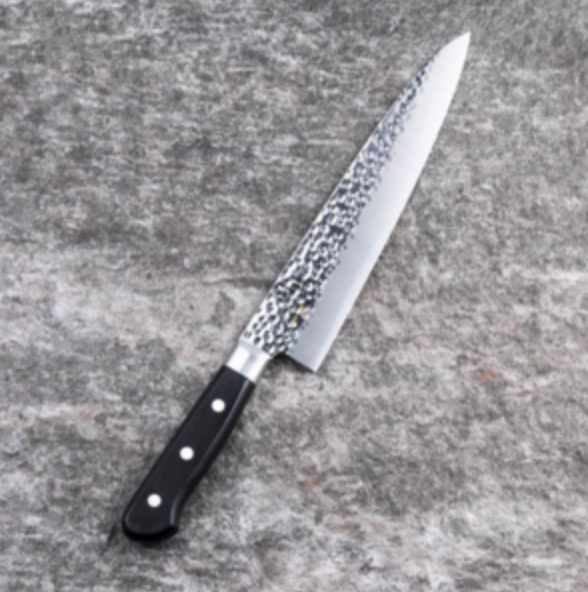
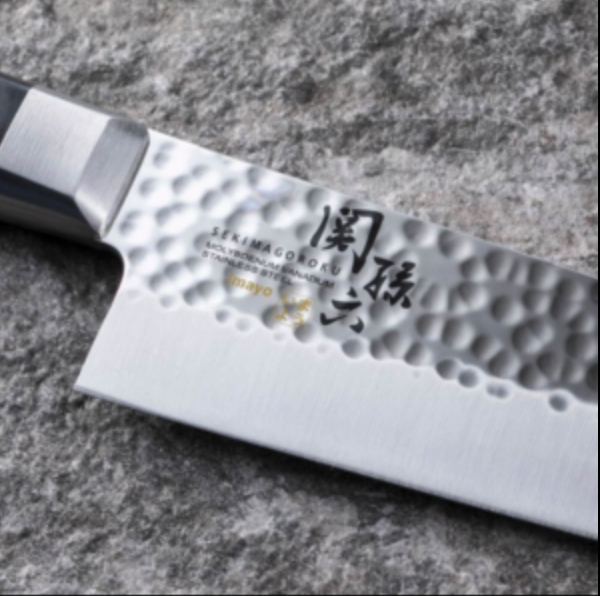
| Aspect | 5-Point Rating |
|---|---|
| Sharpness | ★★★☆☆ |
| Edge Retention | ★★★☆☆ |
| Rust Resistance | ★★★★☆ |
| Ease of Maintenance | ★★★★☆ |
| Aesthetics | ★★★☆☆ |
| Price | $200 |
The “Imayo” line from KAI’s Seki Magoroku series is praised as a knife that balances elegance and practicality. It features a beautiful hammered tsuchime pattern on a single-layer stainless steel blade, offering both aesthetic appeal and functional food release (the dimples help prevent food from sticking to the blade).
It also employs KAI’s unique “three-step Honbazuke” sharpening technique, resulting in a very keen edge right out of the box. The handle is a Western-style made from laminated wood, giving a comfortable grip and a classy look without using rivets (for a clean design).
Home Cooking Enthusiast Review: “This knife strikes the perfect balance between being tough enough for daily use and easy to handle. The first thing that catches the eye is the gorgeous hammered pattern on the blade surface – besides looking great, I suspect it actually helps prevent food from sticking when cutting. Indeed, when slicing something like potatoes, I noticed the slices didn’t cling to the blade and I could chop rhythmically without interruption. Out-of-the-box sharpness was superb; I tested a fine dice on an onion and the blade slid along the grain so fast I finished chopping before the onion could make me cry! Being a monosteel stainless, I don’t worry much about rust – even if I accidentally leave it a bit wet, it’s unlikely to pit, which means I can cook without being overly nervous about the knife at all times. Though it’s 210mm long, the handle is on the lighter side (it has a partial tang Western handle), so the balance is nice and it doesn’t feel heavy. I actually had a female friend try it and she commented, “It’s easier to swing around than I expected for the length,” so it’s gotten positive feedback from different users. Overall, it’s a knife that I can “use hard” every day without worry – sturdy and user-friendly. And the fact that it’s so affordable for this quality (I heard ‘sold 1000 in one day’ on a TV shopping program) is just the cherry on top. It even julienned a cabbage into ultra-fine shreds as if it were a mandoline slicer – I was honestly impressed. The blade has a unique slight curvature (“unyari-ba”wave grind) achieved through special polishing; whatever they did, it results in a smooth cut where you can almost feel the knife suctioning itself to the food in a pleasant way when drawing through. Truly, a remarkable gyuto for the price!)
2nd Place: Shinogi Gyuto 180mm
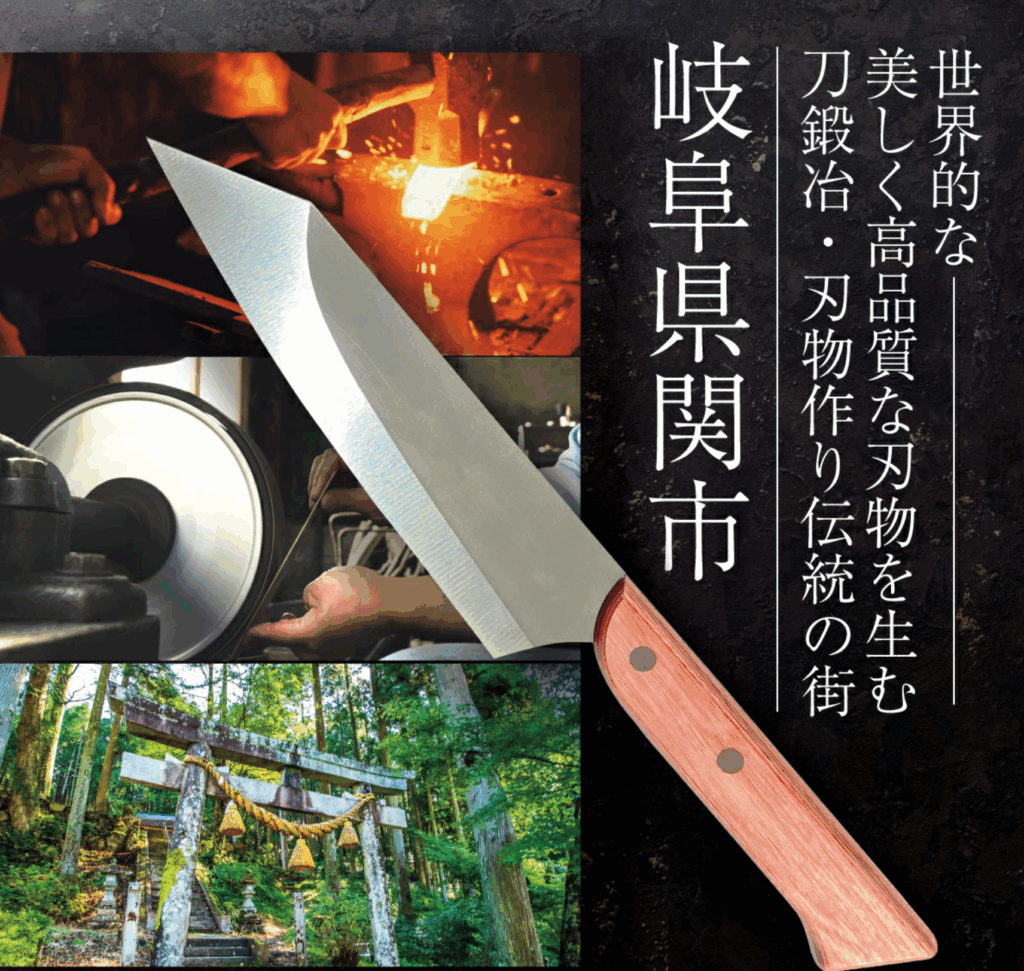
| Aspect | 5-Point Rating |
|---|---|
| Sharpness | ★★★☆☆ |
| Edge Retention | ★★★☆☆ |
| Rust Resistance | ★★★★☆ |
| Ease of Maintenance | ★★★☆☆ |
| Aesthetics | ★★★☆☆ |
| Price | $220 |
The Shinogi knife is designed by merging the best aspects of a gyuto and a santoku. It’s a product developed from a professional perspective focusing on ultimate “ease of cutting.”
It boasts an extremely thin, straight-grind blade (achieved by a special polishing technique) that glides through ingredients with very little resistance. Additionally, the handle features an ergonomic indent for the index finger to rest naturally, enhancing control and comfort.
This knife has gained broad support from professional chefs to home cooks, which speaks volumes about its quality and functionality.
Home Cooking Enthusiast Review: “I saw this knife being featured on a TV shopping show and decided to give it a try – and after using it I thought, “It really does cut amazingly well!” It has a unique shape that’s sort of a hybrid between a gyuto and a santoku, with a distinctive curve where the spine dips down toward the tip (a “curved shinogi” line). Thanks to this design, the blade is thick and sturdy near the heel for heavy work, yet thin and fine toward the tip for delicate slicing – truly the best of both worlds in cutting feel. In practice, when I chunked through a hard sweet potato using the rear part of the blade, it cleaved strongly like a heavier knife; conversely, slicing a ripe tomato paper-thin with the front part, it slid through without crushing it at all. For an 18cm gyuto, it is shockingly lightweight, so even long prep sessions don’t tire my hand. The claim “1000 sold in a day” is no exaggeration – when I shredded cabbage with it, the strands came out whisper-thin, like I’d used a mandoline, and I was amazed. The blade doesn’t have actual wavy serrations, but the innovative grind gives it a remarkably smooth draw and a sense that it bites into the food just right. Also, that integrated handle design with the subtle groove for your index finger? Genius. It naturally guides your grip into a comfortable, secure pinch.
The combination of all these features means this knife is ultra-easy to use for both heavy chopping and fine slicing. As a result, it’s become a beloved tool in both restaurant kitchens and home kitchens, which you can tell by how many positive reviews it gets. It truly lives up to its reputation – a perfect marriage of function and design. The only caveat: because of the very thin edge, one should avoid twisting or prying motions, but with straight cuts it’s durable enough. Overall, a fantastic all-purpose knife that impressed me from day one.”
3rd Place: Ryuji “Stain-Color” Gyuto 210mm
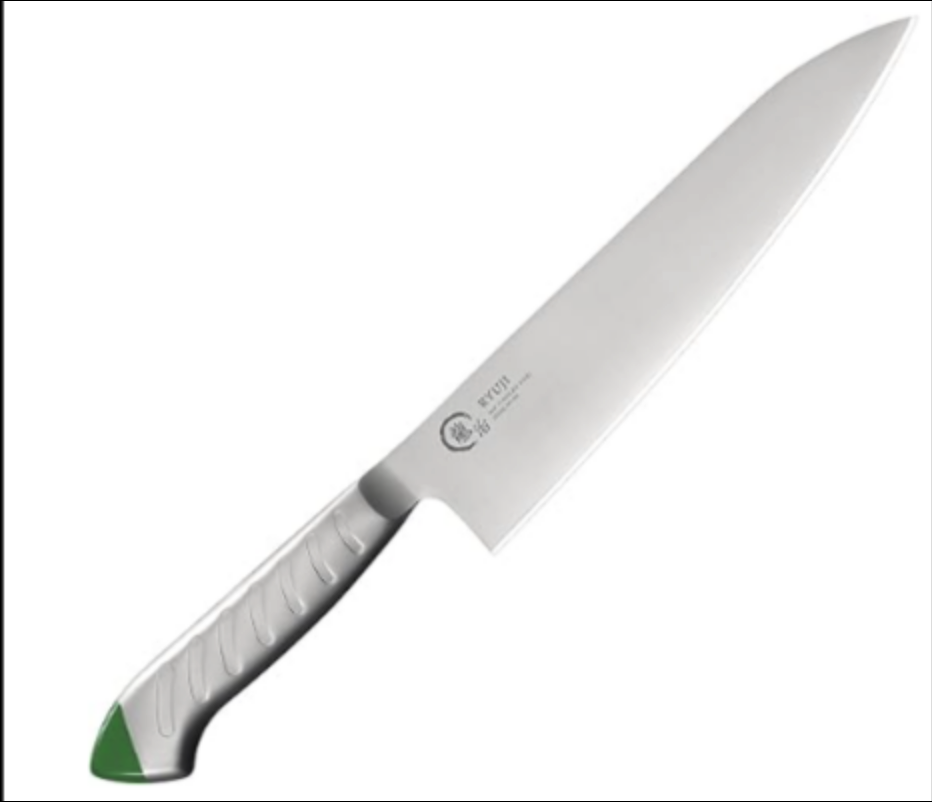
| Aspect | 5-Point Rating |
|---|---|
| Sharpness | ★★★☆☆ |
| Edge Retention | ★★★☆☆ |
| Rust Resistance | ★★★★☆ |
| Ease of Maintenance | ★★★☆☆ |
| Aesthetics | ★★☆☆☆ |
| Price | $150 |
The Ryuji Stain-Color Gyuto is a practical, workhorse chef’s knife aimed at those who need both durability and good cutting performance on a budget. It’s made of a Mo-V stainless steel (molybdenum/vanadium enhanced) known for excellent corrosion resistance and decent edge qualities.
It benefits from precision water grinding by skilled Tsubame-Sanjo craftsmen, giving it a keen edge. The handle is all-stainless and ergonomically shaped according to human engineering principles, offering a secure grip.
All these elements combine to create a gyuto that is highly regarded across settings—from professional kitchens to home use—for its reliability and functionality.
Western Cuisine Chef’s Review: “This is truly a practical knife that pursues ease of use and hygiene. I bought it as part of a series by Shimomura Industrial (the maker), trusting their quality, and it turned out even more user-friendly than expected. First off, it’s very light for a 21cm gyuto, thanks to its hollow, monocoque (monaka) handle construction—when you pick it up, you’re struck by how light it is! This means even long hours of prep don’t fatigue the arms much. It’s clearly designed with professional usage in mind: the balance is slightly blade-forward, so when cutting, the weight of the blade naturally carries it through ingredients—a very comfortable sensation. Initially I worried a metal handle might slip if wet, but upon holding it I realized it has a subtle embossed texture that fits the hand snugly and doesn’t slip even when wet. The handle feels solid despite being hollow; the weight distribution toward the blade makes cutting feel almost effortless as the blade “falls” into foods. The steel used (Molybdenum Vanadium stainless) provides perfectly fine sharpness for everyday tasks, no complaints there.
In use, it slices through ingredients with ease and holds up well—hard carrot and cabbage cores split cleanly without needing brute force, and I haven’t noticed any edge chipping or rolling. The lack of a wooden handle means I can wash it without worry about water, and even toss it in a disinfecting soak when needed, which is great for sanitation in a busy kitchen.
All in all, this gyuto has earned high marks as a reliable workhorse. It’s not flashy, but it performs where it counts: cuts well, resists rust, and is low-maintenance. In a restaurant, where the presentation of the knife doesn’t matter as much as the results on the plate, it has become a real go-to. It handles everything from fluffy brioche to hard baguettes (yes, I even tested it on bread) and, while I wouldn’t replace a serrated knife entirely, it managed without excessive crumbs thanks to its keen edge. Even after heavy use, a quick honing brings the edge right back. Considering the price, it’s an extremely trustworthy blade that stands up in professional environments.”
Nakiri Knives – Top 3 Recommendations
Nakiri knives are traditional Japanese knives designed exclusively for cutting vegetables. Unlike general-purpose knives like the santoku, the nakiri is specialized for veggie prep.
Its defining feature is a thin, flat blade that lets you slice through vegetables without crushing their fibers, creating clean, beautiful cut surfaces. This makes it effortless to process large amounts of produce smoothly and efficiently.
However, the nakiri’s specialization also brings some limitations: it’s not suitable for cutting through meat or bones, and it’s less versatile than multi-purpose knives. Additionally, the thin blade requires careful sharpening—gentle technique is needed to avoid chipping.
In short, a nakiri delivers outstanding performance for neatly and efficiently slicing vegetables, but one should be mindful of its constraints outside that purpose.
Below is a summary of key factors to consider when choosing a nakiri knife:
| Aspect | Examples | Benefits | Cautions |
|---|---|---|---|
| Blade Material | – Stainless Steel: e.g. Molybdenum, AUS-8 – Carbon Steel: e.g. Shirogami (White), Aogami (Blue), Ginsan #3 | – Stainless: Rust-resistant and easy to care for—good for beginners. – Carbon: Extremely sharp edges and a satisfying sharpening experience (pro-level performance). | – Stainless: Slightly less initial sharpness than carbon, and high-hardness stainless models can be pricey. – Carbon: Requires diligent rust prevention (must be dried and oiled). If neglected, can rust or chip more easily. |
| Blade Length | – 16–18 cm: Most common (standard). – < 15 cm: Small/compact. – 20+ cm: Long/pro-size. | – 16–18 cm: Versatile for various vegetables and easy to handle; the typical home-use size. – Short (<15 cm): Very maneuverable in tight spaces or for small hands; light and nimble for fine cuts. – Long (20+ cm): Covers more area per stroke – great for high-volume chopping and professional use. | – Long blades: Can be unwieldy on small cutting boards or in cramped sinks, and some users find very long knives hard to control. – Short blades: You may need multiple passes for large veggies, which can be inconvenient. |
| Price Range | – Affordable: ~¥2,000–¥5,000 (mass-market brands) – good starter or “trial” knives. – Mid-range: ~¥10,000–¥20,000 – many stainless or carbon options. – High-end: ¥30,000+ – often artisan-crafted. | – Affordable: Easy to obtain as a first knife; performance is usually adequate for home cooking. – High-end: Premium materials and craftsmanship yield exceptional sharpness and durability. Owning one can be a pride and a lifetime investment. | – Budget models: May have lower edge durability; require careful use and sharpening. – High-end: Expensive – some might hesitate to spend so much for a “vegetable-only” knife. While hugely satisfying to use, be prepared to maintain it properly to protect your investment. |
| Handle | – Japanese-style: Wood handle (e.g. magnolia, octagonal) → light, non-slip, traditional feel. – Western-style: All-stainless or resin → easy to wash, modern look. | – Wood: Warm, comfortable grip and very lightweight, so hand fatigue is minimal even during long prep sessions. It also develops a nice patina and feel over time. – All-stainless: Sleek and sanitary (no worry about mold); often dishwasher-safe and very durable. | – Wood: Vulnerable to water—if left wet it can warp or grow mold. Needs gentle care (no soaking, dry after use, clean off oil stains). – All-stainless: Can get slippery when wet or with oily hands, so grip can be an issue in long use; some cooks find it lacks the tactile warmth of wood. |
| Weight | ~200–300 g typical (thin blade = lighter weight). Some small nakiris ~150 g. | – Light weight means less arm fatigue during extended chopping. A nakiri’s broad but thin blade is easy to control and doesn’t tire you out. | – Ultra-light models: May feel like the blade “floats” without enough heft. With little weight behind the edge, you must rely on technique (not force) to cut, which some users may find challenging. Those who prefer a hefty knife might find a nakiri too light. |
| Maintenance | – Stainless blade: Rinse and wipe dry after use. – Carbon blade: Wipe dry immediately; oil lightly to prevent rust. | – Stainless: Very easy upkeep and highly rust-resistant—low maintenance. – Carbon: Can take a razor-sharp edge and is rewarding to sharpen for enthusiasts. | – Carbon: Will rust or discolor if not cared for (especially if left wet or with acidic foods). Always dry thoroughly after use. Wood handles also require care to avoid water damage. |
| Sharpening | – Double-bevel: Sharpen both sides ~15–20° equally. – Single-bevel: Sharpen primary side, only light deburring on flat side. – Whetstones: Use ~#1000 grit (main) → #3000–5000 (finish). | – A nakiri’s thin blade can be honed to a razor edge that cleanly slices through veggies without crushing. For those who enjoy sharpening, maintaining a nakiri’s edge can be very satisfying. | – The thin blade is delicate – pressing too hard while sharpening can cause chips. Single-bevel nakiris (rare) are trickier for beginners. While you may not need to sharpen frequently, doing it regularly ensures the best Japanese knife performance from your nakiri. |
| Origin | – Sakai (Osaka): Historic center for nakiri/usuba, many artisan brands. – Seki (Gifu): Famous for Western-style knives; also produces hybrid-design nakiri. – Niigata (Sanjo/Tsubame): Known for stainless steelwork; many all-stainless models. | – Each region has its specialties and subtle differences in finish and blade character, which is fascinating to explore. Knowing where your knife is made can increase your appreciation and encourage good care. | – A famed knife-making region or brand isn’t a guarantee of superiority, but checking a knife’s provenance, brand reputation, and smith’s history can help ensure quality. Top artisan knives are pricey, but they rarely disappoint and often last a lifetime. |
Now, here are our top three picks for nakiri knives:
1st Place: Yoshihiro VG10 Damascus Stainless 165mm
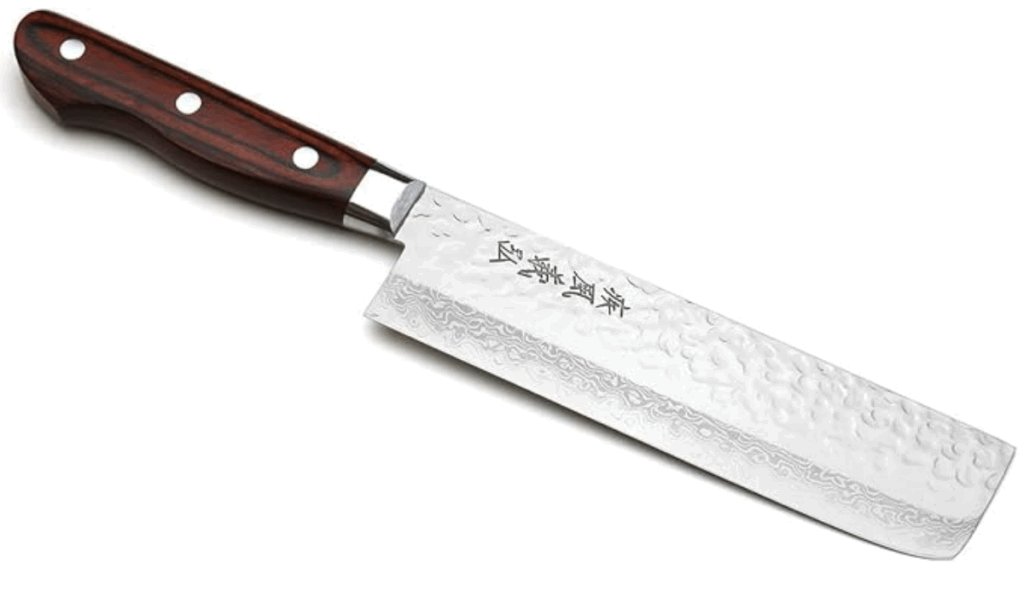
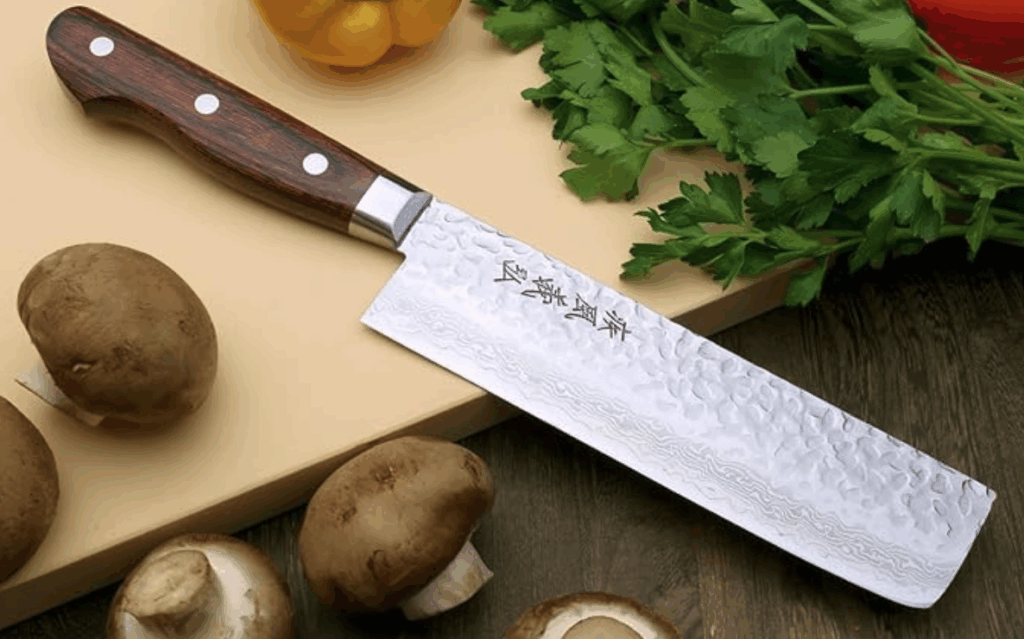
| Aspect | Value |
|---|---|
| Sharpness | ★★★★☆ |
| Edge Retention | ★★★★☆ |
| Rust Resistance | ★★★★☆ |
| Ease of Maintenance | ★★★★☆ |
| Aesthetics | ★★★★★ |
| Price | $400 |
This knife’s hallmark is its exceptional cutting performance and excellent durability. It features a VG10 core encased in multiple layers of Damascus steel, further enhanced by a hand-hammered (tsuchime) finish.
This construction allows it to glide effortlessly through vegetables while effectively preventing food from sticking to the blade. In terms of design, the Yoshihiro stands out with its striking blade pattern—waves of Damascus and hammer marks give it an almost art-like quality—complemented by a mahogany wood handle that adds a touch of luxury.
The Western-style full-tang build provides a stable grip and perfect balance, making it very comfortable to use. However, due to its razor-sharp edge, proper safety and maintenance are essential. Overall, its blend of form and function easily makes it one of the best Japanese knives you can choose for serious vegetable prep—just be sure to handle it with care and keep it well-maintained.
Japanese cuisine chef“This knife has become the star of my kitchen with its beautiful appearance and razor-sharp edge. When I first picked it up, I was mesmerized by the gorgeous Damascus pattern – the mirror-polished blade reveals layer upon layer of rippling waves, and I found myself admiring it even before cooking. But its true value lies in performance: as a nakiri it’s meant for vegetables, and it excels at it. Shredding cabbage or peeling daikon feels like cutting through paper with almost no effort. Even when slicing through a hard daikon, the thin, keen blade meets little resistance and cuts with a satisfying ‘saku!’ and ‘ston!’ sound.”
2nd Place: Miyabi Kaizen II 165mm
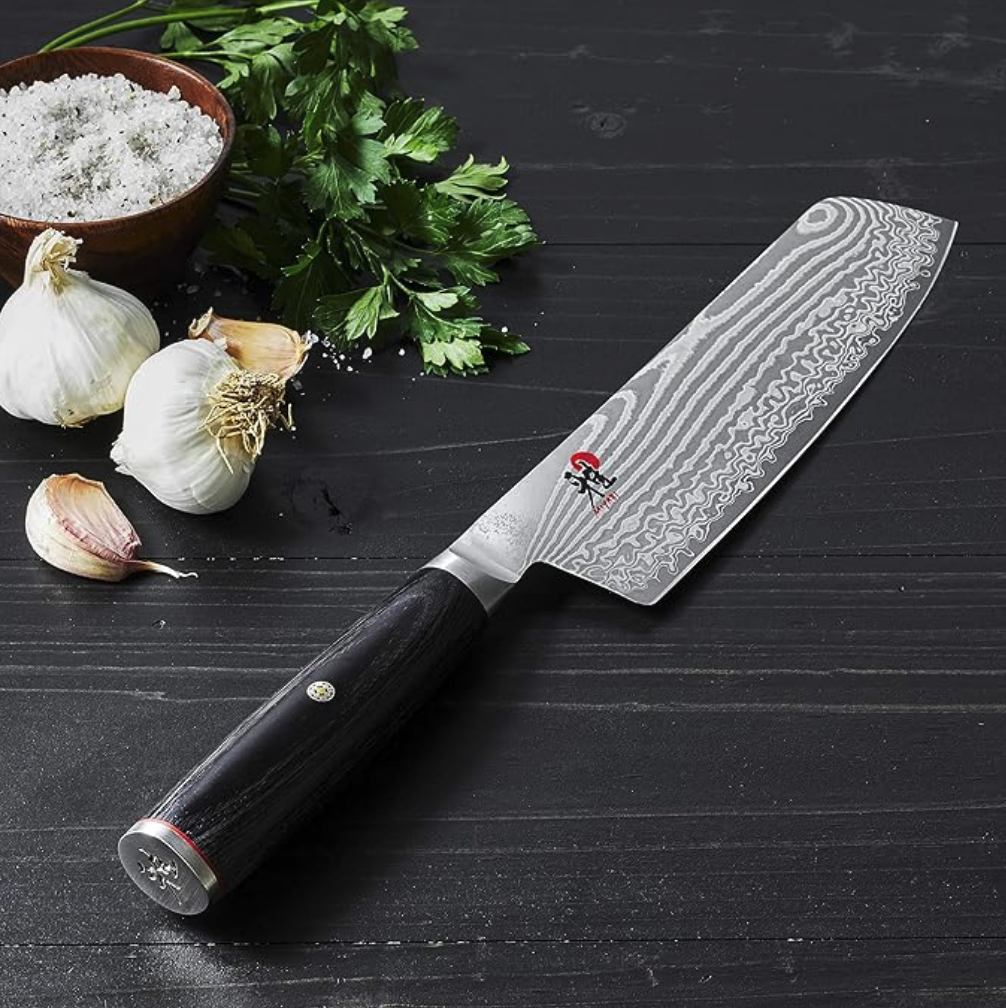
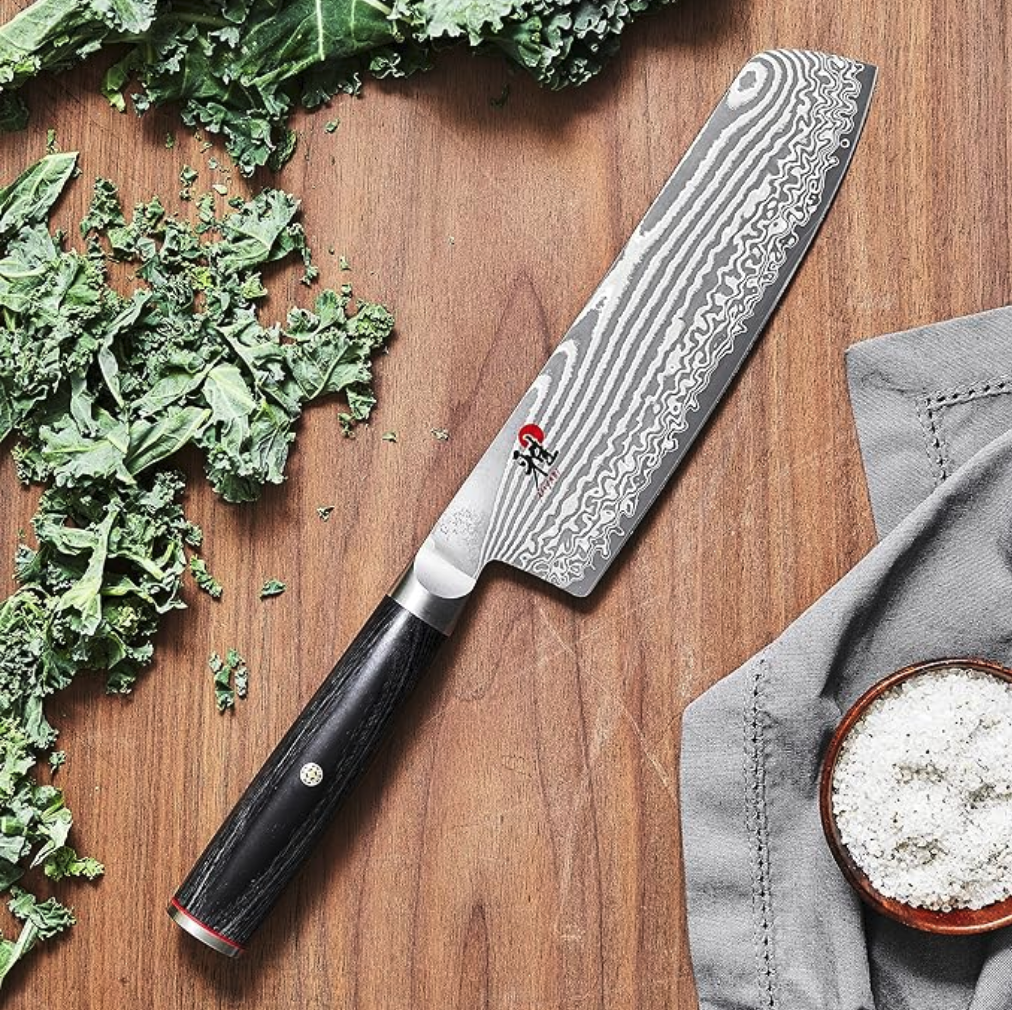
| Aspect | Value |
|---|---|
| Sharpness | ★★★★☆ |
| Edge Retention | ★★★★☆ |
| Rust Resistance | ★★★★☆ |
| Ease of Maintenance | ★★★☆☆ |
| Aesthetics | ★★★★★ |
| Price | $600 |
This knife’s strength is in its sophisticated materials and construction. It uses an FC61 super steel core wrapped in 48 layers of Damascus, achieving a superb balance between a razor-sharp edge and excellent durability.
Thanks to this design, it’s a high-performance knife built to withstand long-term use. The Kaizen II is also a beauty to behold: the blade’s deep Damascus pattern and the refined D-shaped handle combine to exude a luxury that’s hard to find elsewhere.
It truly epitomizes the concept of functional beauty. In use, it does not disappoint—through an ice-hardening process and a four-step Honbazuke sharpening by artisans, this knife can smoothly slice through just about anything, from heaps of vegetables to cuts of meat or fish, all with one knife. Additionally, its ergonomically designed handle provides an easy, comfortable grip that helps reduce fatigue in long sessions.
Japanese cuisine chef “The black-and-red contrast of the beautiful Japanese-style handle and the blade’s intricate Damascus pattern immediately catch the eye. In actual use, when cutting vegetables, the blade slides in with a crisp ‘swaap’ sound and leaves an impressively smooth surface. For example, even slicing a ripe tomato – this knife can push-cut straight through and slice the skin cleanly without needing to saw. At 165mm it’s a standard size nakiri, but the blade has just the right thickness to keep it stable, so I can confidently chop through larger cabbages or heads of lettuce with ease.”
3rd Place: Okouryu (Kōkoku-ryū) Version MT Nakiri 155mm
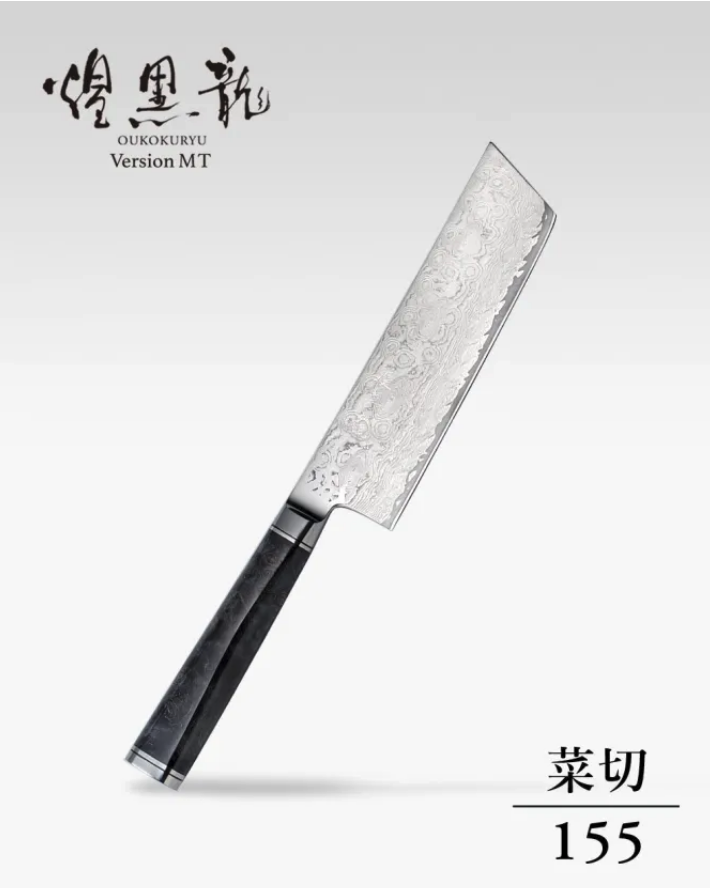
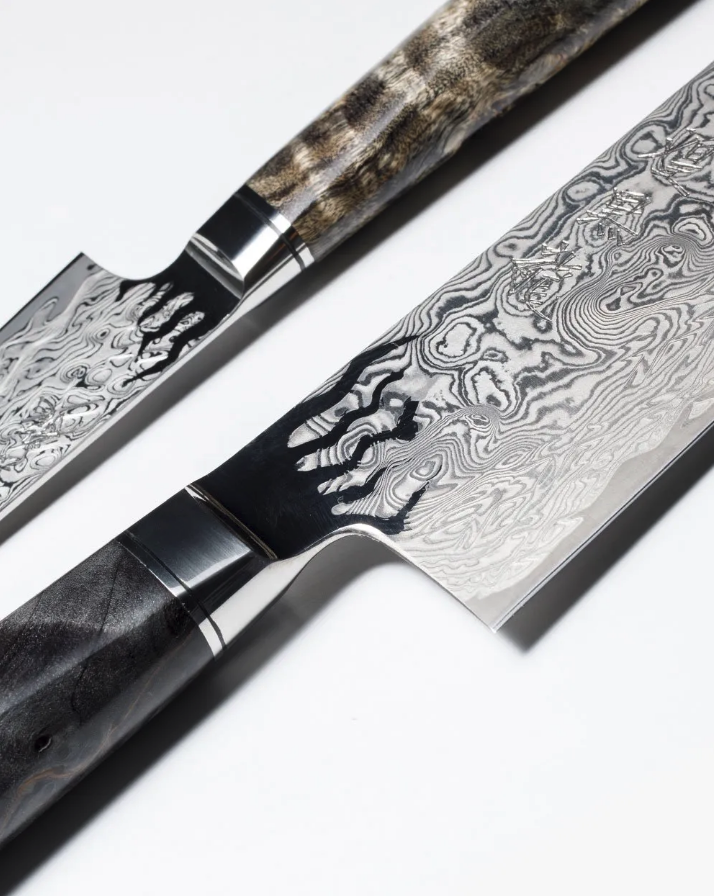
| Aspect | Value |
|---|---|
| Sharpness | ★★★★☆ |
| Edge Retention | ★★★★☆ |
| Rust Resistance | ★★★☆☆ |
| Ease of Maintenance | ★★★★☆ |
| Aesthetics | ★★★★★ |
| Price | $900 |
The Okouryu series takes its aesthetic to the next level in this “Version MT” model. The most distinctive feature of this new series is the unique “flame-like” wavering pattern applied at the junction of the blade and handle. Each of these artistic flourishes is meticulously hand-finished by skilled craftsmen. This bold design element is deeply meaningful: it embodies the image of “blaze” – symbolizing the fusion of a chef’s passion and a smith’s masterful technique. The flame motif at the blade’s bolster, painstakingly created by hand, enhances the knife’s functional beauty and gives it the aura of a one-of-a-kind art piece.
Continuing the legacy of the previous model, the Version MT further evolves in both form and function. It boasts an even more refined Damascus pattern across the blade and improved weight balance around the handle. The blade uses an SG2 (R2) powder steel core wrapped in 99 layers of nickel Damascus, delivering an incredibly sharp and smooth cut. The inclusion of the signature handcrafted “flame” motif makes this knife truly unique.
Japanese cuisine chef“This is a high-end nakiri that I’d call a true work of art, both in looks and performance. From the moment I held it, I was struck by its hefty feel and the exquisite details in every inch. The blade features a dark, mystical cloud-like Damascus pattern, and the proud ‘煌黒龍’ logo is etched boldly. It looks almost too beautiful to use, like a sword, but once I started cutting vegetables, I was twice as amazed. The edge is unbelievably sharp and silky – even vegetables I usually find tricky to slice (like soft tomatoes or eggplants) glide under the blade as if I’m just setting the knife down and pulling it lightly. The cut surfaces glisten like a mirror. With its weight and balance, chopping through something like a big daikon is effortless, and slicing feels controlled and precise. It’s an extraordinary knife that combines the soul of craft with sheer cutting power.”
Bread Knife Recommendation Rankings
A bread knife is a knife designed specifically for cutting bread, characterized by a serrated or wavy blade edge. This serration allows you to slice through soft bread interiors and hard crusts without crushing them, so you can maintain clean, even slices. Bread knives typically have a long blade, which makes it easy to handle large loaves or thick crusts, and they’re also handy for tasks like slicing cakes.
Below is a table with common bread types, examples, and a suggested blade length for each. These are general guidelines, so you should adjust based on the actual size of the bread and what feels comfortable:
| Type of Bread | Examples | Recommended Blade Length |
|---|---|---|
| Hard, long breads | Baguette, bâtard | 25–30 cm |
| Medium loaf breads | Sandwich loaf (shokupan, Pullman) | 20–25 cm |
| Large round breads | Boule, campagne | 25 cm or more |
| Small breads & pastries | Dinner rolls, pastries, Danish | ~20 cm |
| Moderately hard, mid-size | Bagel, baguette for sandwiches | 20–25 cm |
Now, here are the top three recommended bread knives:
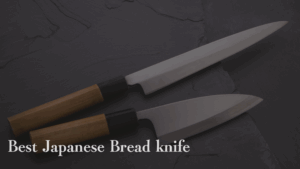
1st Place: Kai Shun Sora Bread Knife 225mm
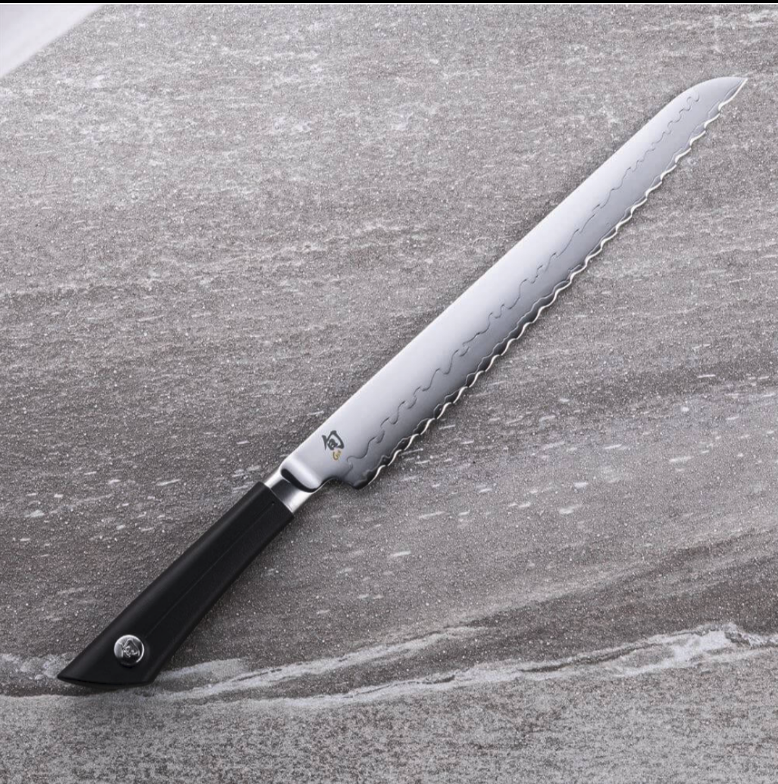

| Aspect | Value |
|---|---|
| Sharpness (Cutting Ability) | ★★★☆☆ |
| Edge Retention | ★★★★☆ |
| Rust Resistance | ★★★★☆ |
| Ease of Maintenance | ★★★☆☆ |
| Aesthetics | ★★★★★ |
| Price | $200 |
The Shun Sora is a bread knife line from Kai (the makers of the famous Shun knives). The Shun Sora Bread 225mm features a scalloped serrated edge that, with a gentle back-and-forth sawing motion, can neatly slice even delicate breads or sticky cheeses without crushing them.
Additionally, its blade is made with a 33-layer clad construction of stainless steel of varying hardness, which creates a beautiful Damascus pattern on the blade surface—making it as visually impressive as it is functional. In terms of performance, this knife offers professional-level sharpness and has earned a reputation for cutting cleanly with minimal bread crumbs.
“I’ve used many bread knives, but this one is pretty much ideal. The sharp serrations cut through bread without compressing the loaf. It handles soft sandwich bread as well as crusty baguettes and campagne with surprising smoothness. In particular, when slicing for sandwiches, the cuts are perfectly clean and even, which really elevates the presentation. The handle is well designed and ergonomic, so even after slicing a lot of bread my hand isn’t tired. This knife would easily hold its own in a professional bakery environment.”
– Artisan baker
“In a bakery or restaurant, the knife’s sharpness makes all the difference in the finished slice, and this bread knife offers top-tier precision. Even bread with a hard crust – the blade bites in cleanly and yields a beautiful cut without needing extra force. It doesn’t tear the bread’s delicate internal structure and produces almost no crumbs, which means less waste and better efficiency. It looks refined and feels very reliable in hand. This knife can instantly become a workhorse in a bakery or restaurant setting.”
– Restaurant chef
2nd Place: YO-U (“Yō”) Bread Knife 200mm
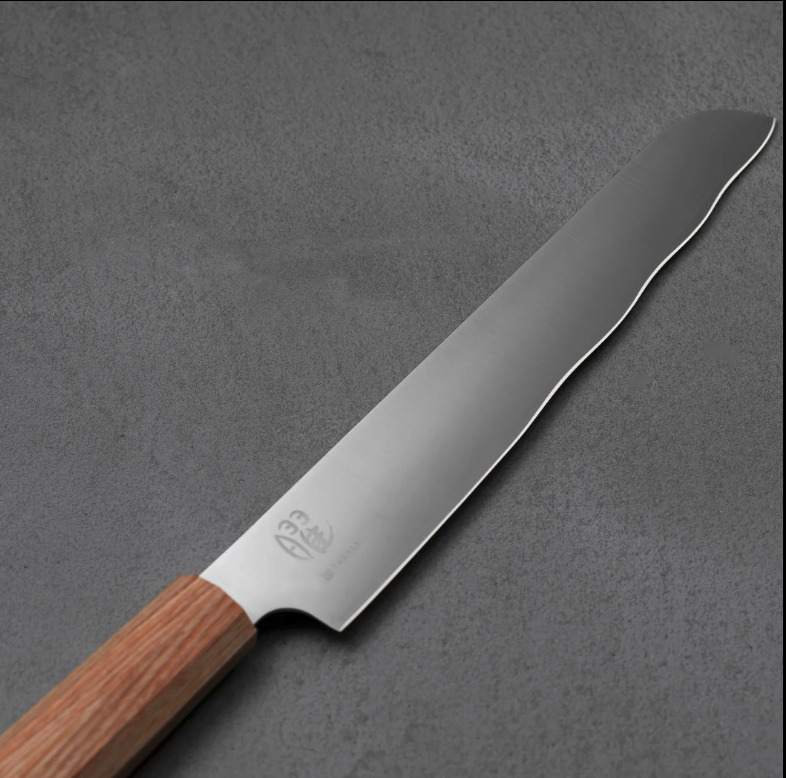
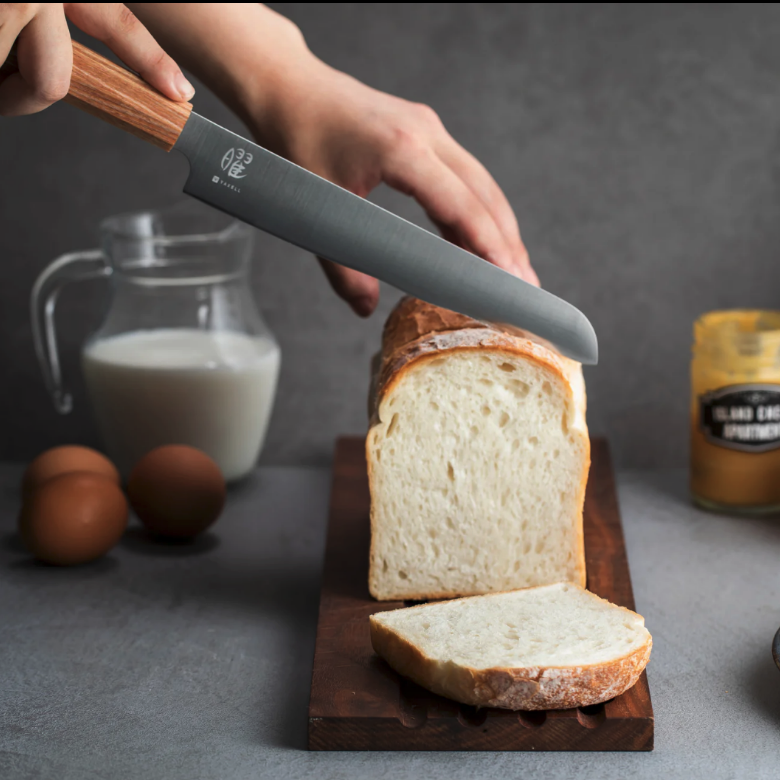
| Aspect | Value |
|---|---|
| Sharpness (Cutting Ability) | ★★★☆☆ |
| Edge Retention | ★★★★☆ |
| Rust Resistance | ★★★☆☆ |
| Ease of Maintenance | ★★★☆☆ |
| Aesthetics | ★★★☆☆ |
| Price | $200 |
The YO-U bread knife is designed to slice bread cleanly without crushing the loaf, leaving a beautiful cross-section. It achieves ideal slices without compromising the bread’s texture or flavor. The design is sleek and refined as well, bringing an attractive look to your kitchen. This knife is highly rated by both bread enthusiasts and professional bakers alike.
“A bread knife needs a delicate sharpness and ease of handling, and the YO-U delivers superbly. From fresh, fluffy loaves to well-baked baguettes, the blade slides in smoothly and creates neat slices with no excess effort. The serration design is excellent – it produces very few crumbs, which is a big plus. It’s a reliable knife that has boosted our prep efficiency and improved the quality of dishes we serve.”
– Professional baker
“When serving bread in a restaurant, the beauty of the slice is crucial, and the YO-U bread knife excels at this. Its blade is very sharp, so it cuts smoothly without needing force, handling everything from soft brioche to crusty baguette. The serration is cleverly designed to minimize crumbs, keeping the workspace cleaner. It’s definitely a knife that can become an instant asset in a professional kitchen.”
– Restaurant chef
3rd Place: Sakai Ichimonji Mitsuhide G-Line Bread Knife (Serrated)

| Aspect | Value |
|---|---|
| Sharpness | ★★★☆☆ |
| Edge Retention | ★★★★☆ |
| Rust Resistance | ★★★☆☆ |
| Ease of Maintenance | ★★★★☆ |
| Aesthetics | ★★★☆☆ |
| Price | $200 $150 |
Sakai Ichimonji Mitsuhide’s G-Line Serrated Bread Knife uses high-hardness VG1 stainless steel, which gives it excellent sharpness and edge retention. Its serrated blade design allows you to smoothly cut through even hard-crusted bread while keeping crumb generation to a minimum.
This knife is forged in one piece (all-steel construction) and is highly regarded by professional chefs – it maintains its performance even during heavy, long-term use. The handle is designed for comfort and a secure grip, which helps reduce fatigue during work.
“In bread prep, a knife’s performance really determines the outcome. The Sakai Ichimonji Mitsuhide G-Line uses VG1 steel for a sharp, durable edge. Even on a hard-crusted baguette, the blade slides in smoothly and produces a beautiful cut surface. The serration is well engineered so you can cut soft bread without squashing it, and hardly any crumbs fall, which keeps the prep area tidy. It’s a reliable knife that becomes an immediate workhorse in a professional bakery environment.”
– Artisan baker
“From delicate freshly baked loaves to well-baked hard breads, the G-Line bread knife handles them all perfectly. It’s extremely sharp and, thanks to its good edge retention, it stays sharp through long sessions. The handle balance is excellent, so even with extended use my hand doesn’t tire out easily. For restaurants or bakeries that put a premium on bread service, this knife is a trustworthy choice.”
– Restaurant chef
ありがとうございます! 「中華包丁のおすすめランキング」と「筋引き包丁のおすすめランキング」の各セクション全体を、これまでと同様に参考文体に合わせた自然なアメリカ英語で翻訳します。 表やレイアウトもできる限り維持し、SEOワード「japanese knife」「best japanese knife」「top rated japanese knife」も意識して仕上げます。 翻訳が完了したらすぐにお届けしますので、少しお待ちください!
Chinese Cleaver Recommendation Rankings
A Chinese cleaver (chukabocho) is a knife with a broad, rectangular blade, widely used in Chinese cooking. There are both thin-bladed and thick-bladed varieties. This versatile knife can be used not only for cutting ingredients, but also for tasks like crushing ginger with the spine of the blade or scooping up chopped food with its wide blade surface.
Below is a table of recommended Chinese cleaver sizes depending on usage. Actual ideal dimensions vary by manufacturer, model, and material, but you can use these as general guidelines when choosing:
| Intended Use | Blade Length (approx) | Blade Width (approx) | Blade Thickness (approx) | Characteristics & Benefits |
|---|---|---|---|---|
| Fine prep (scallions, ginger, etc.) | 14–17 cm | 8–10 cm | 2–3 mm | Small and easy to handle, suited for delicate work. Lightweight, making fine cutting and decorative carving easier. |
| General purpose (vegetables, meat, fish) | 18–21 cm | 10–12 cm | 2–4 mm | A standard size that accommodates the broad uses of Chinese cooking. The wide blade makes it easy to scoop ingredients and allows flexible handling of various cuts. |
| Cutting through bone-in meat or hard foods | 22–25 cm | 11–13 cm | 3–5 mm | Large and thick, strong against impact – ideal for chopping through bones or hard ingredients. The added weight enables powerful chopping that takes advantage of the blade’s sharpness. |
| High-volume prep (professional use) | 25+ cm | 12+ cm | 4+ mm | Oversized in both weight and dimensions. Excellent for processing large quantities of ingredients efficiently and with greater force, but requires experience to handle effectively. |
Now, let’s look at our top three recommended Chinese cleavers. Each of these is a top rated Japanese knife offering outstanding performance for professional use.
1st Place: Shun Classic Chinese Cleaver 175mm
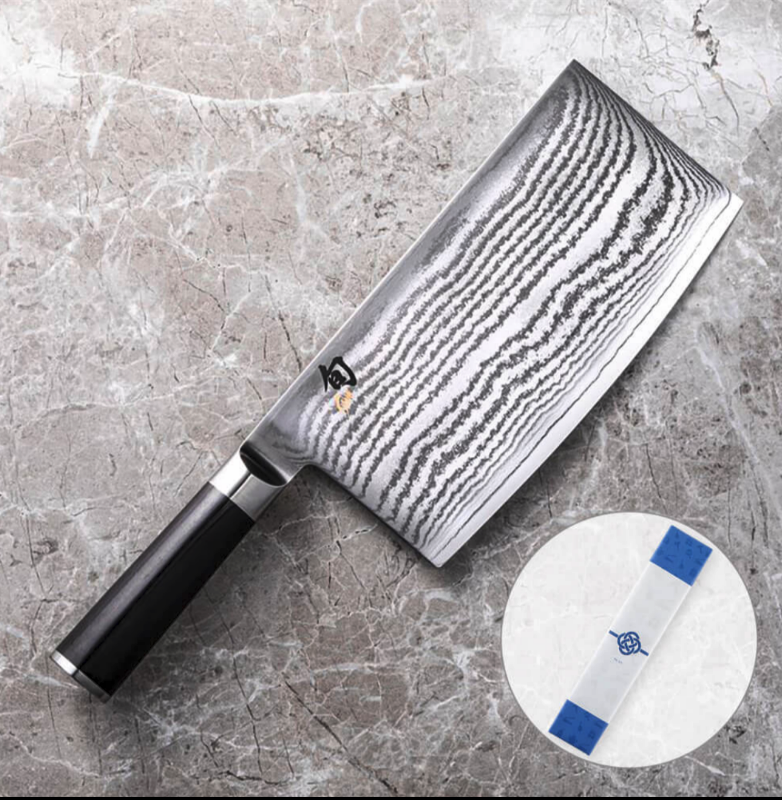
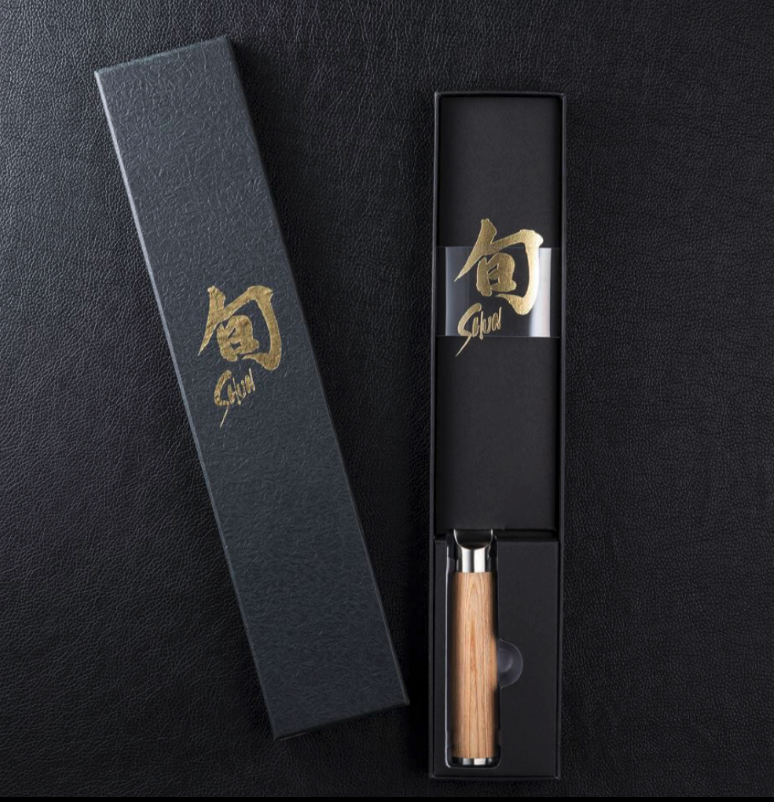
| Aspect | 5-Point Rating |
|---|---|
| Sharpness | ★★★★☆ |
| Edge Retention | ★★★★☆ |
| Rust Resistance | ★★★★☆ |
| Ease of Maintenance | ★★☆☆☆ |
| Aesthetics | ★★★★★ |
| Price (Blade 175 mm × 89 mm) | $400 |
Kai’s Shun Classic Chinese Cleaver (175mm blade) features a wide, square blade for versatile use. It uses a high-hardness, high-carbon VG-MAX steel core, which means the razor-sharp edge stays sharp for a long time.
This knife excels at handling large vegetables like cabbage, and it can slice fruits and meats with ease. However, it’s not meant for chopping through bones or joints. The D-shaped pakkawood handle (with a rivet-free design) is comfortable to hold and adds a refined look, nicely complementing the knife’s beautiful Damascus-patterned blade.
Review: This Chinese cleaver is packed with Japanese craftsmanship – I’m in love with its elegant look and incredible sharpness. Many Chinese cleavers have a somewhat utilitarian, rugged appearance, but this one stands out with its gorgeous Damascus blade and sleek black pakkawood handle, giving it the aura of a high-end chef’s knife. At 175mm, it’s on the smaller side for a cleaver, which actually made it very manageable in my home kitchen. It’s also relatively lightweight, so it handles smoothly on a Japanese cutting board. Even as a first-time cleaver user, I was able to get comfortable with it quickly.
Review: In professional settings, edge retention is crucial – and the Shun Classic Chinese Cleaver delivers. The VG-MAX steel’s hardness allows for precise, clean cuts, leaving vegetables and meats with beautifully smooth cut surfaces. You can also use the blade’s weight to cut through foods without crushing them, which helps preserve the ingredients’ texture. The knife is well-balanced for a cleaver and has an easy-to-grip handle that gives you stable control. All in all, it’s a highly practical tool that any busy pro kitchen would appreciate.
2nd Place: Tojiro PRO Chinese Cleaver 220mm
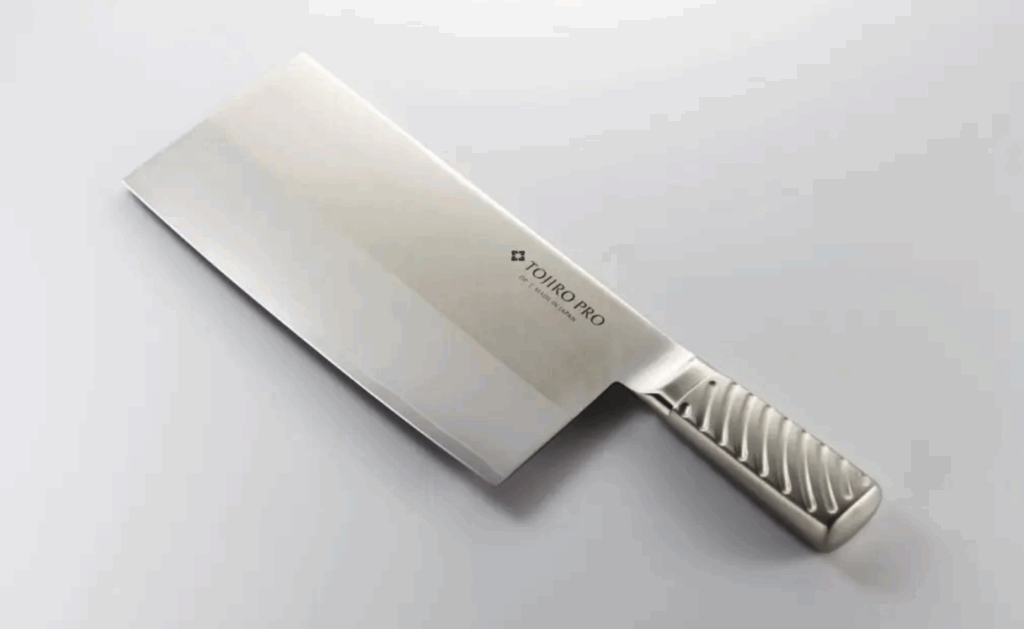
| Aspect | Value |
|---|---|
| Sharpness | ★★★☆☆ |
| Edge Retention | ★★★★☆ |
| Rust Resistance | ★★★★★ |
| Ease of Maintenance | ★★★☆☆ |
| Aesthetics | ★★★★☆ |
| Price (220 mm) | $350 |
The Tojiro PRO Chinese Cleaver 220mm is an all-stainless design with a distinctive handle pattern. This cleaver uses a VG10 high-carbon stainless steel core in a multi-layer (warikomi) construction, achieving excellent sharpness while remaining easy to maintain.
The all-stainless handle has a unique “tornado” texture that provides a secure, non-slip grip; it’s also hygienic and very durable. The characteristically wide cleaver blade is great for everything from chopping ingredients to scooping them up, making this knife a dependable choice even in professional kitchens.
Review: This is a true pro-grade cleaver, combining toughness with functional beauty. The moment I picked it up, I was struck by the ruggedly cool all-stainless look of the knife. With its 220mm blade and broad profile, I expected it to feel unwieldy and heavy, but the hollow-built stainless handle (monaka construction) means it’s not as heavy as it appears – in fact, the balance is excellent. The center of gravity is toward the blade, so the knife’s own weight naturally aids each chop as you bring it down. By letting the cleaver’s heft do the work, I was able to split even hard carrots and cabbage cores cleanly in half with ease.
3rd Place: Sakai Jikko “Gin-3” Chinese Cleaver
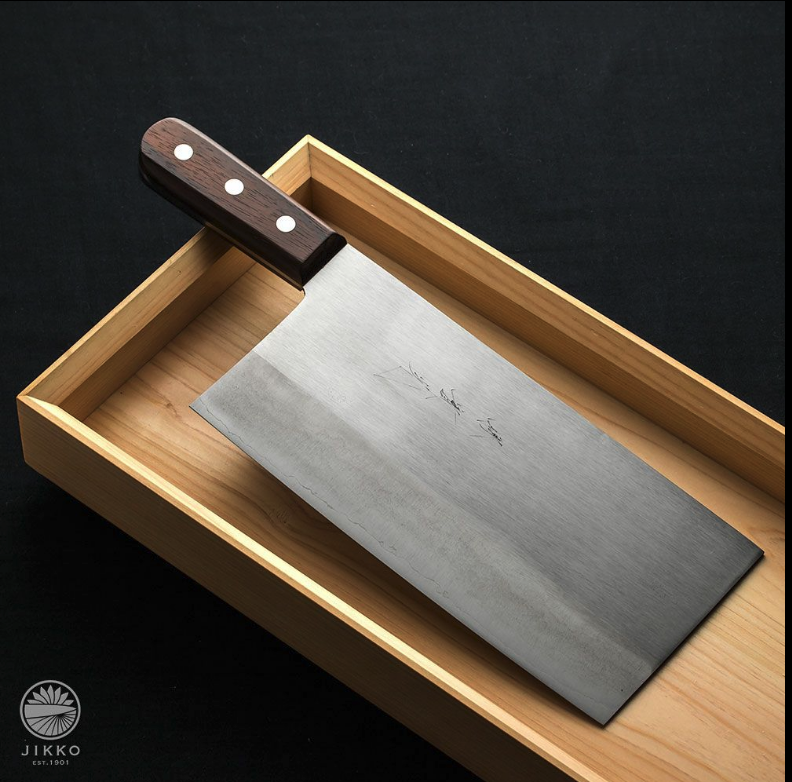
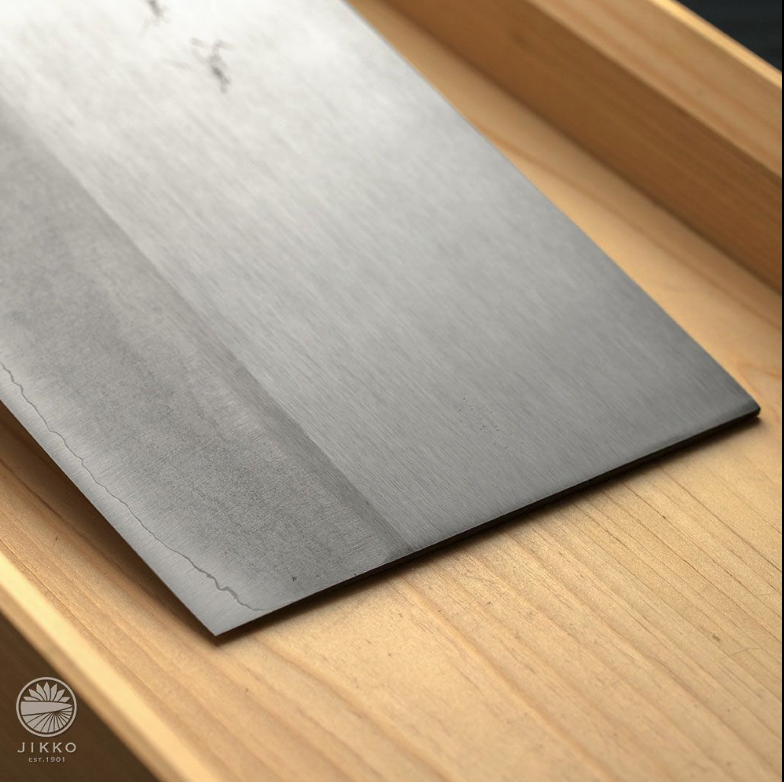
| Aspect | Value |
|---|---|
| Sharpness | ★★★☆☆ |
| Edge Retention | ★★★★☆ |
| Rust Resistance | ★★★☆☆ |
| Ease of Maintenance | ★★★★☆ |
| Aesthetics | ★★★★★ |
| Price (Blade 220 mm × 110 mm) | $1000 |
The Sakai Jikko “Gin-3” Chinese Cleaver is made with traditional craftsmanship and quality steel. This cleaver from Sakai Jikko uses high-grade Silver #3 (Gin-san) stainless steel for its blade, which is known for delivering excellent sharpness while being resistant to rust.
Gin-3 is also one of the easier stainless steels to sharpen, and it’s popular among professional chefs for its great balance of performance and maintenance. The broad, rectangular blade – typical of a Chinese cleaver – handles everything from cutting ingredients to scooping them up, making this knife a reliable partner in any professional kitchen.
Review: This knife is a unique powerhouse that fuses traditional Japanese blade craftsmanship with the brawn of a Chinese cleaver. Silver #3 steel is famous for being rust-resistant and very sharp, but it’s rarely used in cleavers – so I was intrigued to try it, and it turned out to be a fantastic choice. I was amazed by how clean and beautiful it cuts. When I sliced a cucumber, the cut surface was so smooth that tiny droplets of moisture beaded up and glistened, almost as if the cucumber was sweating from the clean cut. The cutting performance honestly rivals that of a carbon steel cleaver, yet since it’s a stainless-based steel it’s much less prone to rust, which makes upkeep so much easier. I sometimes chop a big pile of cabbage with a cleaver and might leave the blade sitting with moisture on it for a bit – with this knife I don’t have to panic if the blade stays slightly damp momentarily (of course, I still wash and dry it promptly). In short, the Gin-3 cleaver delivers carbon-steel-like sharpness with stainless convenience, and that’s a huge win for busy chefs.
Sujihiki Knife Recommendation Rankings
A sujihiki is a slim, long-bladed Western-style knife used to smoothly slice through meat or fish, particularly for trimming sinew and skin. It’s also ideal for carving roast beef or ham into thin, even slices – in fact, many chefs consider a sujihiki the best Japanese knife for slicing large roasts and hams. This style of knife is equally handy for preparing dishes like carpaccio or even sashimi, where precision slicing is required.
Below is a table of recommended sujihiki blade lengths based on their main uses. Choose a length appropriate for your needs and kitchen space – the right size will be easier to handle and improve your efficiency:
| Intended Use | Recommended Blade Length | Notes & Details |
|---|---|---|
| General slicing tasks (meat, fish in general; sashimi, carpaccio) | ~240mm | A standard size that works for a wide range of uses. Highly versatile from home kitchens to restaurant use. |
| Portioning large cuts / carving roast beef (when dealing with big cuts at restaurants or BBQs) | ~270mm | The longer blade allows you to make a long slicing stroke in one go, which helps produce clean, even slices. |
| Professional high-volume slicing (slicing large hams or meat blocks in bulk) | 300mm+ | Can quickly process large quantities and big pieces of meat. However, a blade this long requires experience and plenty of space to use safely and effectively. |
Now, let’s introduce our top three recommended sujihiki knives for professional use.
1st Place: Sakai Jikko “Flare” Sujihiki 240mm
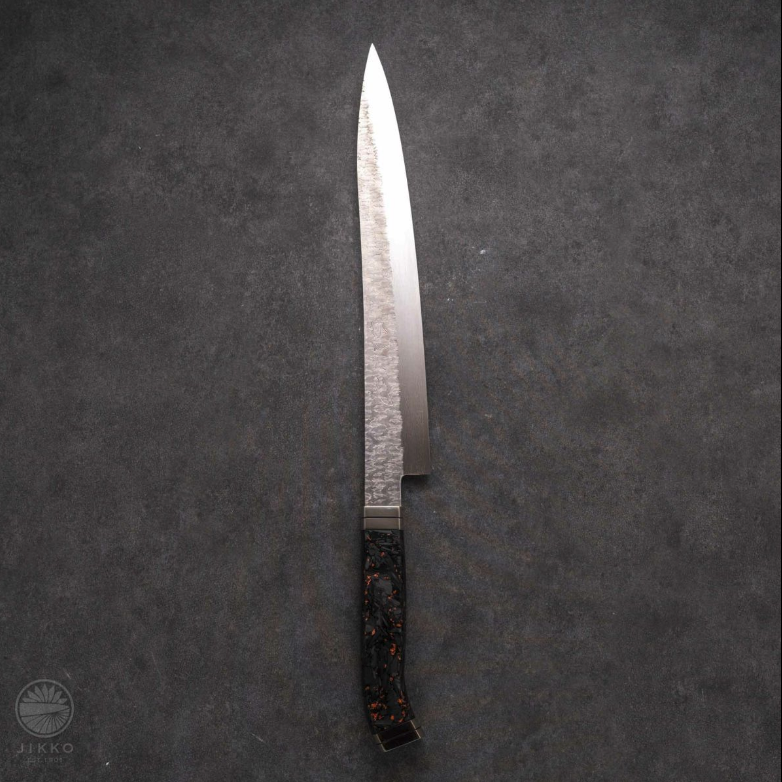
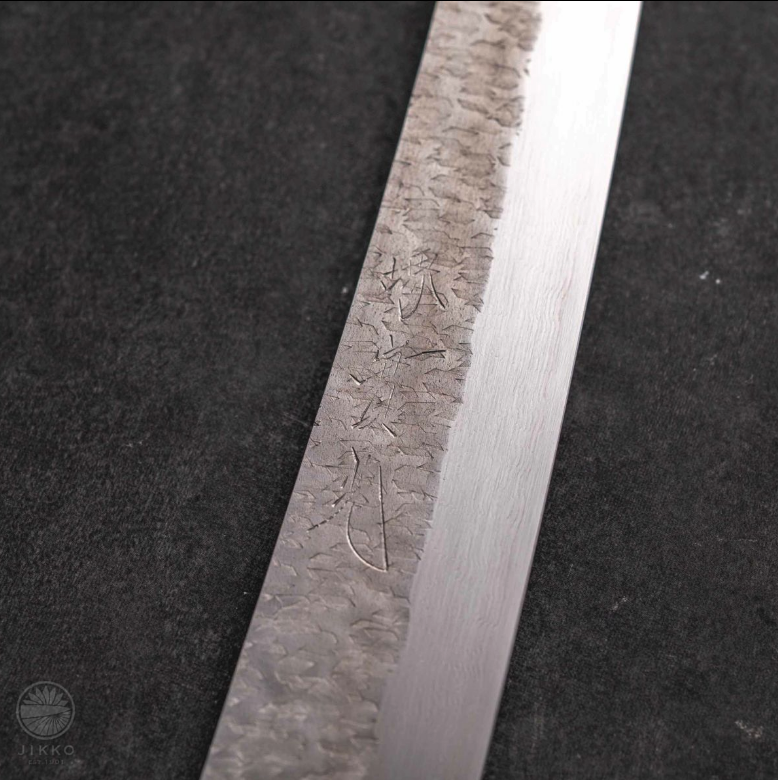
| Aspect | Value |
|---|---|
| Sharpness | ★★★★★ |
| Edge Retention | ★★★★☆ |
| Durability | ★★★★★ |
| Ease of Maintenance | ★★★★☆ |
| Aesthetics | ★★★☆☆ |
| Price | $700 (240 mm) $900 (270 mm) (including tax) |
The Sakai Jikko “Flare” Sujihiki is a premium slicing knife made with a state-of-the-art steel.
This high-end knife uses SPG STRIX, one of the newest and most advanced Japanese knife steels (introduced in 2024). SPG STRIX is a powdered stainless steel with extremely high hardness, enabling a razor-sharp edge and exceptional edge retention.

Despite its hardness, it remains rust-resistant and is surprisingly easy to sharpen, making the Flare sujihiki an outstanding performer in every respect.
Review: I purchased the 240mm version, and from the moment I held it I was blown away by the quality. The blade uses this new powder steel, and it offers even sharper cutting and longer edge life than I imagined. Although the steel is extremely hard, I found it surprisingly easy to sharpen on a whetstone – just a few passes, and the edge snaps back to razor sharpness. In actual use, it feels like the blade slides through ingredients with almost no resistance; it cuts through meat sinew and skin without a hint of stress. The octagonal wooden handle fits my hand perfectly, and the knife’s balance is exquisite, so even during long slicing sessions my hand doesn’t get tired. The price is certainly on the high side, but the performance absolutely justifies it – for anyone looking for a truly top-of-the-line sujihiki, this blade could be a once-in-a-lifetime partner.
2nd Place: Masahiro Sujihiki 270mm (with Bolster)
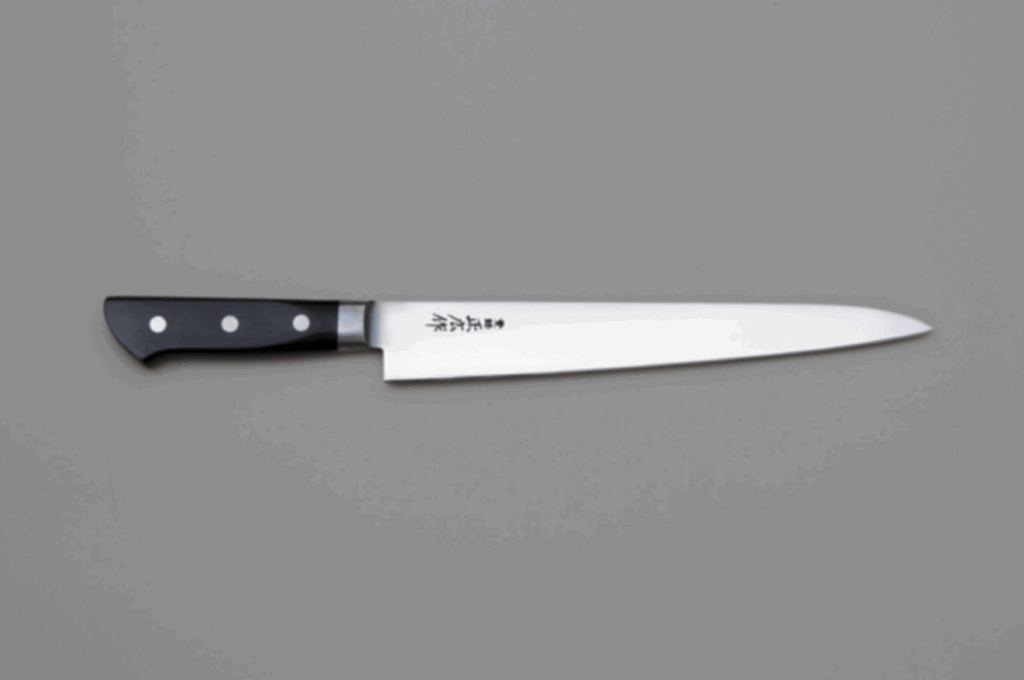
| Aspect | Value |
|---|---|
| Sharpness | ★★★★☆ |
| Edge Retention | ★★★★☆ |
| Durability | ★★★☆☆ |
| Ease of Maintenance | ★★★☆☆ |
| Aesthetics | ★★★★☆ |
| Price | $300 |
The Masahiro 270mm Sujihiki is a classic Western-style slicer with a sturdy bolstered handle. Masahiro’s 270mm sujihiki uses the company’s proprietary high-carbon steel (ZCD-U), which gives it excellent, long-lasting sharpness.
The blade is 270mm long and the knife weighs around 200g, allowing for precise, controlled slicing without feeling too heavy. The handle is made from layered reinforced wood infused with an antimicrobial agent for hygiene.
An integrated metal bolster and full tang construction further enhance the knife’s durability and balance. This is a professional-grade slicer that becomes more and more comfortable as you break it in over time.
Review: As expected from a pro-oriented knife, you can feel the sturdiness and excellent balance as soon as you hold it. The long 270mm blade is fantastic for slicing through large cuts of meat in one go – it made carving thin slices of roast beef a breeze. The high-carbon steel has a well-balanced mix of hardness and toughness, so the edge really lasts. I found I could draw this knife through a steak with almost no effort at all, which has significantly sped up my prep work. The handle design, with its bolster and full tang, gives a very solid, confident feel – the joint between blade and handle is reinforced and inspires trust when you’re slicing. Because it is a carbon steel knife, you do have to be diligent about cleaning and drying it after use to prevent rust. However, as long as you take care of it, it’s easy to re-sharpen and will reward you with a consistently razor-sharp edge.
3rd Place: Seisuke VG10 33-Layer Mirror Damascus Sujihiki 240mm
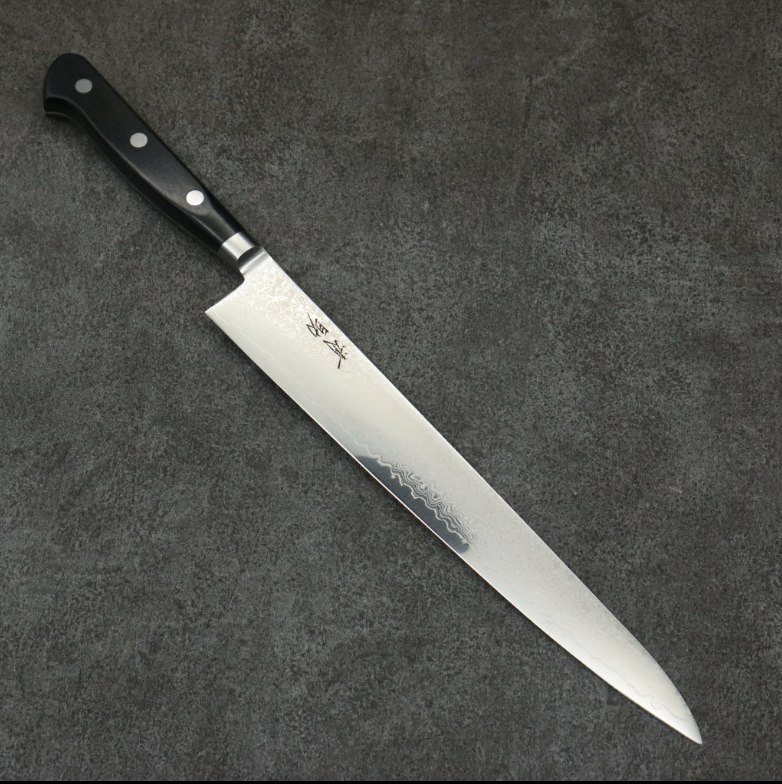
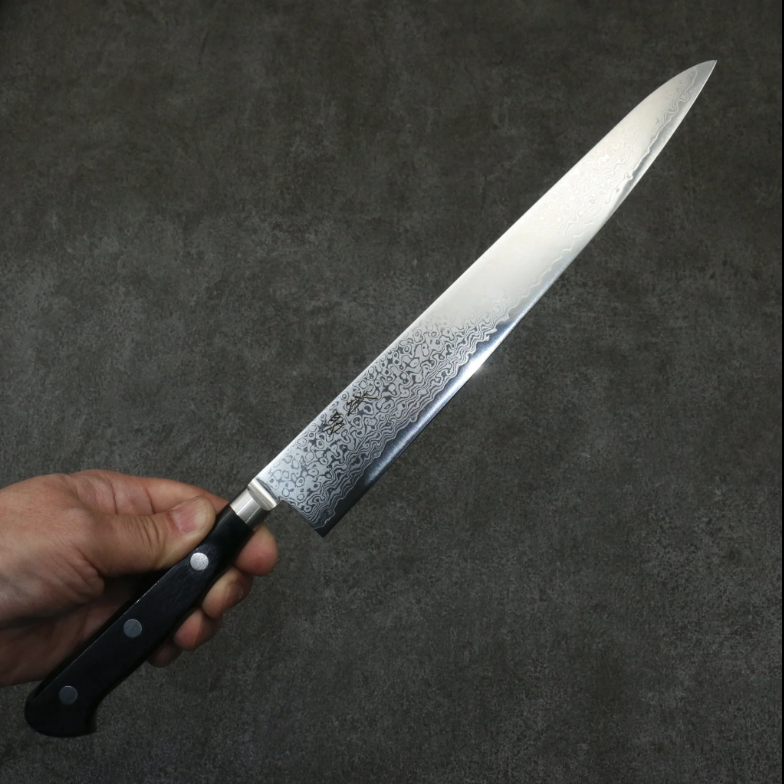
| Aspect | Value |
|---|---|
| Sharpness | ★★★☆☆ |
| Edge Retention | ★★★★☆ |
| Rust Resistance | ★★★☆☆ |
| Ease of Maintenance | ★★★☆☆ |
| Aesthetics | ★★★☆☆ |
| Price (225 mm model) | ¥$170 |
The Seisuke 240mm Damascus Sujihiki is an eye-catching knife with performance to match its looks. This sujihiki features a VG10 stainless steel core and a stunning 33-layer Damascus pattern that’s polished to a mirror finish.
It delivers a combination of keen cutting performance and rust resistance, making it perfect for slicing meats and fish. The mahogany wood handle provides a secure, comfortable grip and is designed to minimize fatigue even during extended use.
This is a versatile knife that can shine in a professional chef’s hands, yet is approachable enough for home cooks as well.
Review: The first thing that grabs your attention is the blade – the 33-layer Damascus pattern is polished to a mirror-like shine, and it’s absolutely beautiful. But this knife isn’t just about looks; it also delivers excellent performance. The VG10 stainless core provides a sharp edge that lasts well and offers decent rust resistance. Despite the longer blade, it handles comfortably, giving you the flexibility to slice through a roast or prepare sashimi with equal ease. The handle is a laminated wood that resists water and grime and is extremely durable, so you can really put this knife to work without it wearing out. The price is very reasonable given the quality, making this knife a perfect choice for anyone looking for a gorgeous Damascus-style blade that doesn’t sacrifice practicality.
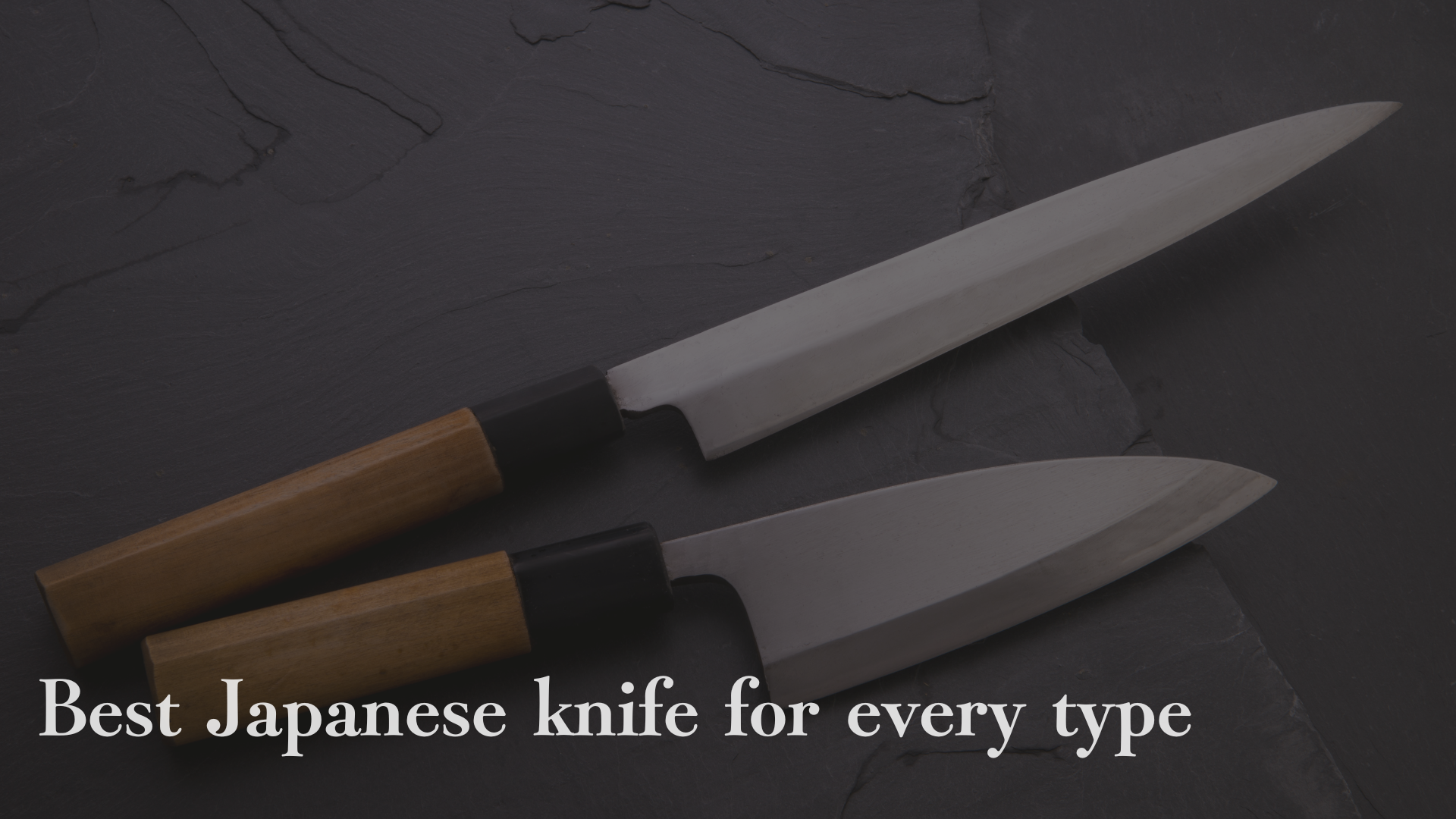
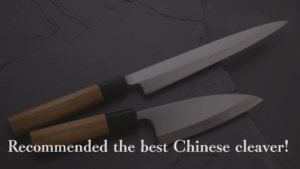
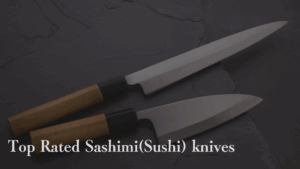
Comments